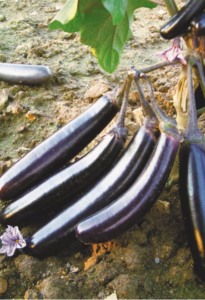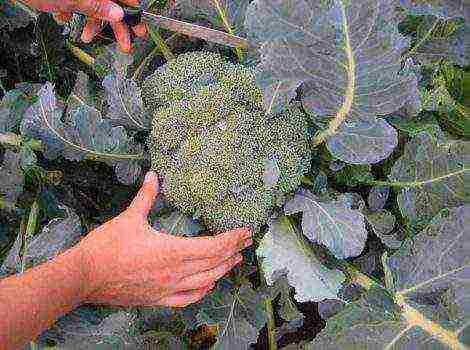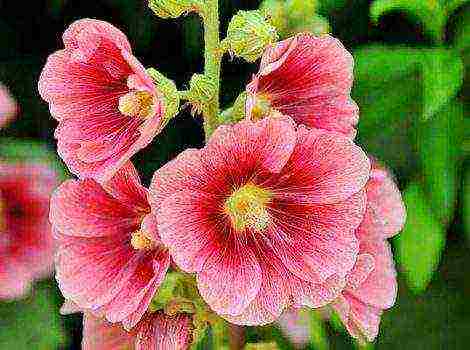Content
- 1 Perennial chrysanthemums
- 2 Choosing a place in the garden
- 3 Care
- 4 Reproduction
- 5 Annual chrysanthemums
- 6 Varieties and varieties of chrysanthemums
- 7 Dates for planting chrysanthemums in open ground
- 8 Chrysanthemum care
- 9 Dependence of the beginning of flowering on the length of daylight hours
- 10 Storing chrysanthemum roots in winter
- 11 Reproduction
- 12 Diseases and pests
- 13 Large-flowered cut chrysanthemums: varieties that allow you to create bouquets
- 14 Perennial and annual chrysanthemums: varieties and their photos
- 15 Spherical garden varieties of chrysanthemums with names and photos
- 16 Korean chrysanthemums - placers of small inflorescences
- 17 Single-headed large-flowered varieties of garden chrysanthemums (with photo)
- 18 White varieties of chrysanthemums - exquisite freshness and purity
- 19 Early varieties of chrysanthemums with names and photos for growing in the garden
- 20 Garden varieties of chrysanthemums in the catalog with names and photos
- 21 Characteristics of bush chrysanthemum
- 22 What types are there?
- 23 Which variety should a novice gardener choose?
- 24 How to grow chrysanthemum correctly?
- 25 How to prolong the freshness of cut chrysanthemum flowers?
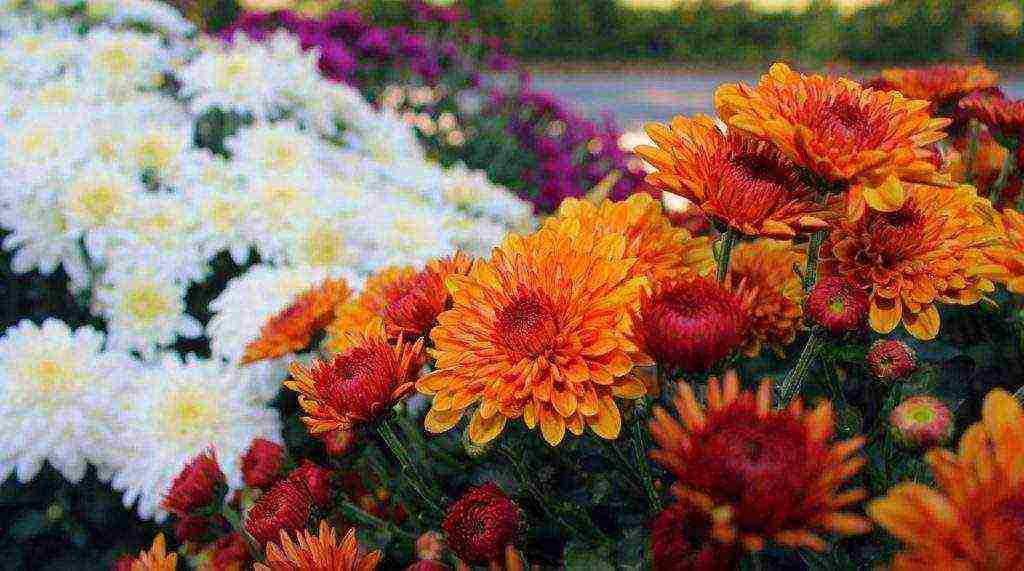
The beauty of an autumn garden is impossible without the flowering of multi-colored varieties of chrysanthemums.
Perennial chrysanthemums

Chrysanthemums have been cultivated by people for two and a half thousand years, and during this time more than 10,000 varieties have been created. All this variety of perennial chrysanthemums is usually divided into two groups.
- Indian large-flowered.
- Korean small-flowered.
Indian chrysanthemums
They are distinguished by very large double flowers. They are thermophilic; in the open field they grow only in the southern regions. In the middle lane and the Moscow region, they can only be grown in greenhouses. They bloom in late autumn or early winter. Used to make bouquets.
Popular varieties of Indian chrysanthemums
Gazell

"Gazelle"
Early flowering variety of English origin. The flower is white, with double petals, large - on average 14 cm, but can reach 17 cm in diameter, hemispherical. The length of daylight affects the decorativeness of a flower: the longer the day (about 10 hours), the more beautiful the shape of the flower. The stem is strong
'Valentina Tereshkova'
Crimean variety, blooms in early September with crimson flowers. It has the disadvantage of a brittle stem; a garter is required during cultivation. The flower stands very well in cut.
Alec Bedser
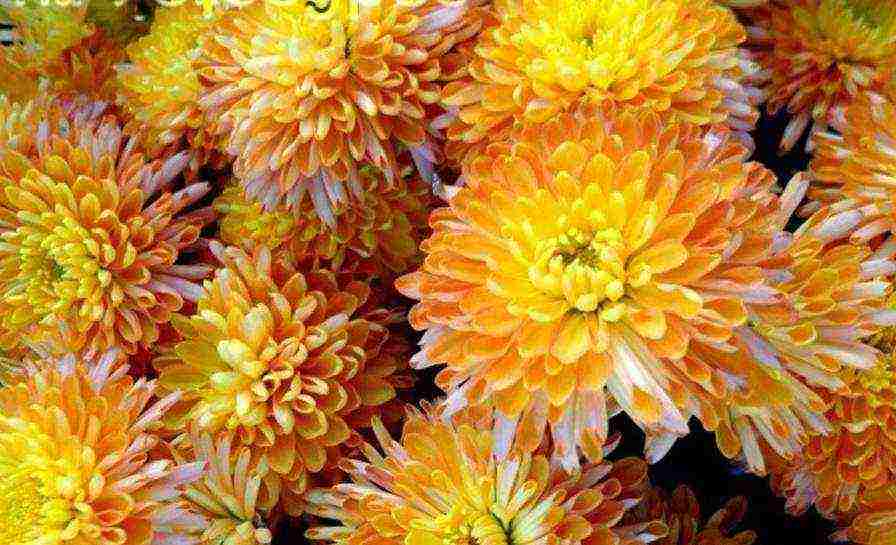
'Alec Bedser'
Blooms in late September in large (up to 14 cm), hemispherical, golden cream flowers.
Korean chrysanthemums
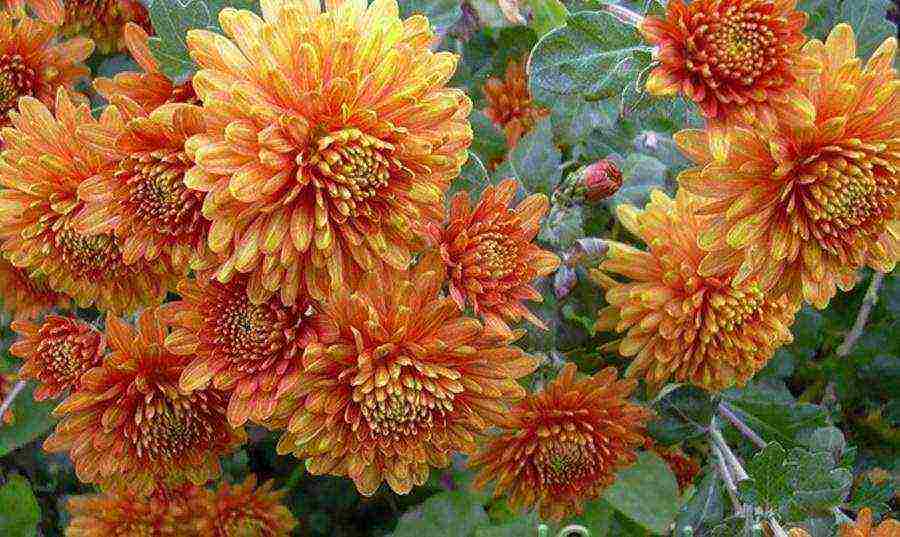
Of the perennials in the climate of central Russia in the open field, you can successfully grow Korean chrysanthemums and only those varieties that bloom in the early (July-August) and middle (September-October) periods.
Korean chrysanthemums are a hybrid species that grows as a multi-stemmed bush with a branched rhizome giving stolon-like underground shoots. The stems are straight, herbaceous, woody by the end of the season, with a height of 30 to 90 cm. The leaves are gray-green in color, with their rugged shape reminiscent of oak, hence the popular name of these chrysanthemums "oak".They bloom in late August - mid-September with inflorescences of various colors and bloom until frost, decorating an already faded garden.
Korean chrysanthemums include many varieties with simple, semi-double and double flowers in a wide variety of colors. When used in garden design, for convenience, they are classified according to their strength of growth into the following groups:
- Low-growing (curb) up to 30 cm
- Medium height 30-50 cm
- High 50-90 cm
Low-growing varieties bloom from the end of July for a month. Their spherical dense bushes look good on the front rows of flower beds, in pots, in borders.
Medium-sized varieties have a wide variety in color and bloom from July - August to one and a half months.
Tall varieties of chrysanthemum form large flowers. It blooms from late August until frost. A voluminous bush will decorate the back and middle row of the flower garden.
Korean chrysanthemum varieties
Malchish-Kibalchish
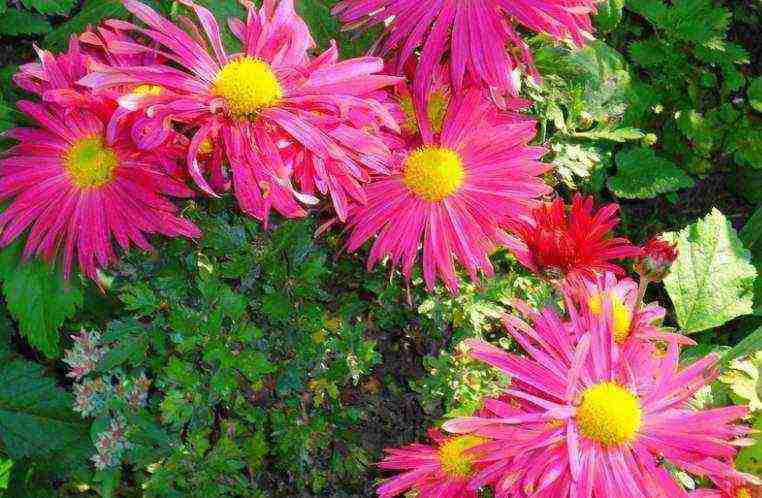
Malchish-Kibalchish
Low-growing variety, bush height about 28 cm. It blooms at the end of July and blooms during the month with abundant lilac-pink, non-double flowers, reminiscent of chamomile. The size of the flower is about 7 cm. It does not bush, therefore, for greater decorativeness, it needs to be pinched in the middle of the season.
Amber
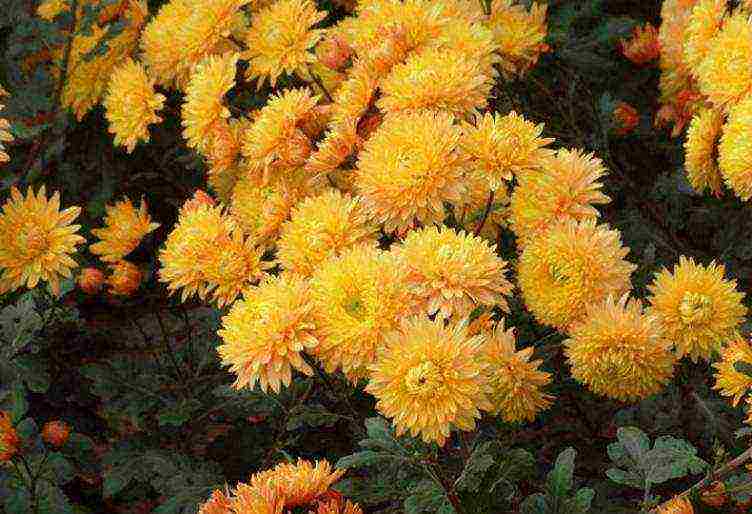
Amber
Blooms in rich yellow double flowers. Forms a neat dense bush 50 cm high. It grows well due to root growth - up to 50 cm in diameter.
Alyonushka
It blooms in September with non-double, bright pink "daisies", 5-6 cm in diameter. Forms a small bush in volume up to 50 cm high.
Snow White

Snow White
Bushes are erect, compact, 60-70 cm tall. Terry inflorescences, 6-7 cm in diameter, white. Blooms in September.
Bacon
Blooms in October with red-red double flowers up to 6 cm in diameter. This is a tall chrysanthemum - the bush grows up to 80 cm.
Far East
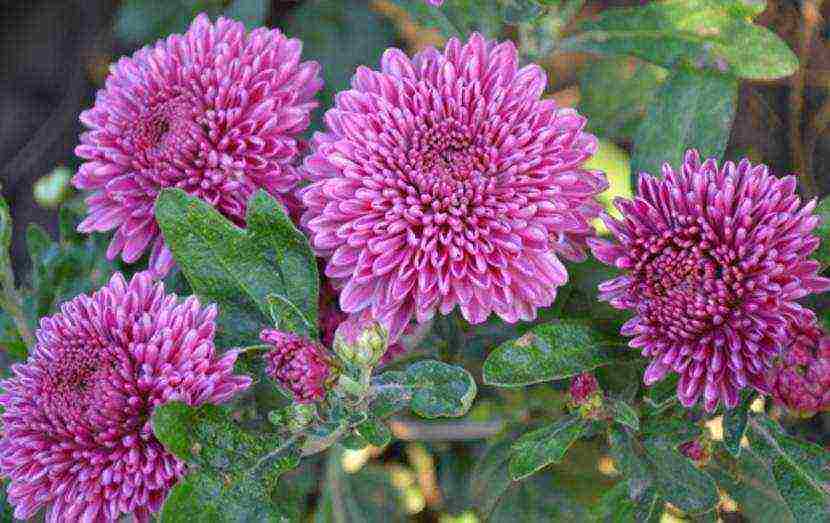
Far East
Chrysanthemum early flowering. Sprawling wide bush grows up to 45-50 cm high. It blooms with double, pompom-like lilac flowers. Flower size 5 cm. Flowering lasts for a month. The variety is resistant to adverse conditions, winters well.
Alexandrite
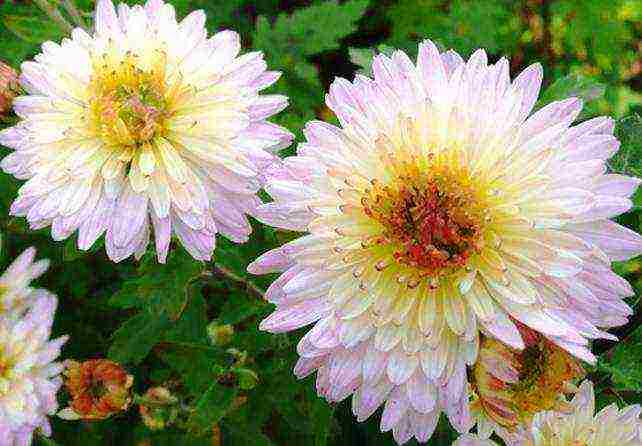
Alexandrite
Low (35-40 cm), early flowering variety. Semi-double flowers, pink with yellow, 5 cm in diameter, appear in August.
Altgold
A neat bush up to 60 cm tall blooms at the end of August. Double flowers, bright yellow, 5-7 cm in diameter.
Summer
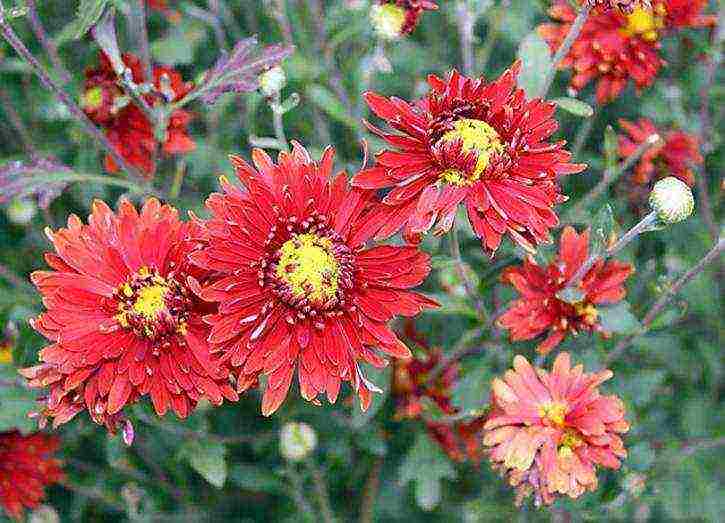
Summer
Early blooming, tall variety: stems 80 cm high. Flowers are large, non-double, reddish-red. Flowering begins at the end of July and lasts about one and a half months.
Umka
It blooms in September with terry pom-shaped white flowers, 4-5 cm in diameter. The bush is upright, rather high: 50-80 cm. To increase the abundance of flowering, it is recommended to pinch the peduncles. Flowering is long, lasts until frost.
Choosing a place in the garden

If you want to decorate your garden with blooming chrysanthemums, you need to know how to properly plant this plant and how to care for it.
For planting chrysanthemums in the garden, you should choose well-lit places. In shady areas, the flowering will be less bright and short-lived. Strongly ventilated places are not recommended for placing chrysanthemums, as well as confined spaces where air stagnates. It should not be where chrysanthemums grow and stagnant water. Chrysanthemums will grow well on light, moderately fertile soils with normal acidity (pH 7).
Summing up the above, in a place where chrysanthemums will grow should not be:
- shadows,
- wind,
- constant excess of moisture in the soil,
- stagnant air.
Planting chrysanthemums in raised flower beds will be successful.
Starting to prepare a place for planting, they dig up the soil, adding humus or compost to it at the rate of 15 kg per 1 sq. m and 20-40 g of complete mineral fertilizer.
Do not add fresh manure and do not overdo it with nitrogen fertilizers - plants "fatten" and do not bloom well
Care
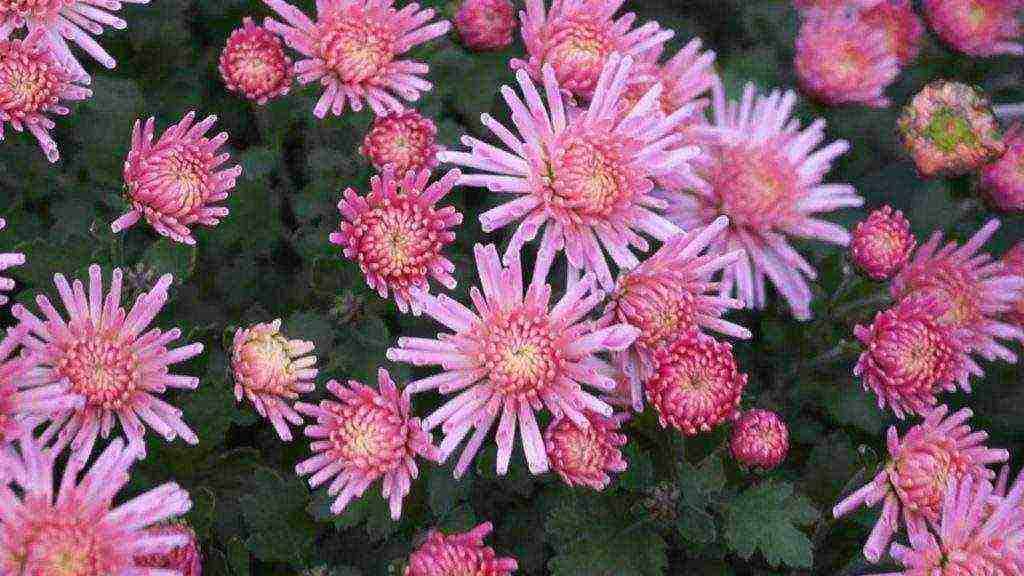
When caring for chrysanthemums, it is important to carefully monitor soil moisture: a lack of watering leads to lignification of the shoots and a decrease in flowering, and excessive moisture can lead to decay of plants.
Watering is intensified in June-July, at which time the plants are picking up buds. In August, on the contrary, watering is stopped.
From the end of June, with an interval of two weeks, they begin to feed the plants with a mullein solution (1:10) with the addition of phosphorus and potassium fertilizers (20 g per 10 l of water). Top dressing is combined with watering.
Korean chrysanthemums are grown in bush form, without forming. To improve branching, 1-2 pinching of shoots is sometimes done.
If you need large inflorescences for bouquets, then start shaping the bushes in advance. For this purpose, remove all stems, except 3-4 and, as they grow, break out the shoots in the leaf axils.
For a long life in your garden, chrysanthemums must be divided and transplanted at least once every 3 years. In central Russia, this is usually done in June and the cuttings are immediately planted in the ground.
Shelter for the winter
Korean chrysanthemums are highly resistant to low temperatures: even during flowering, they are not afraid of frosts down to -10 degrees, having thawed, they continue to bloom. However, it is recommended to snatch planting for the winter. After flowering, the stems are cut at a height of 15-18 cm, at the end of autumn the bushes are mulched with peat, and then covered with dry branches, spruce branches and dry leaves.
Reproduction
Chrysanthemums can be propagated in the following ways:
- Seeds.
- Cuttings.
- By dividing the bush.
Seed method reproduction is used for breeding purposes, since the varietal characteristics of plants grown from seeds are not preserved.
How it's done.
Seeds are sown in May in open ground. Seedlings appear on 5-15 days. After the formation of 1-2 true leaves, a pick of the seedlings is carried out. In autumn, plants are planted in a permanent place with a distance of 20 or 30 cm between seedlings.
Division of bushes can be carried out for 3-4 years of cultivation. Do it in the fall or spring. The bush is dug up and divided so that each division has 3-4 shoots. Old lignified and dead parts are removed.
Cuttings... With this method of propagation, the tops of young basal shoots 5-8 cm long are cut off by cuttings, the bottom leaf is removed and planted on shaded, specially prepared beds in a layer of sand, deepening the cutting by about 1 cm.Rooting occurs in 2-4 weeks. Rooted plants at the end of August can be planted in a permanent place in the garden.
Application in the garden
Low varieties with a beautifully leafed bush will look good in curbs and when planted in containers. Higher varieties are used in single and group plantings, in mixborders, together with perennial flowers and annuals.
Annual chrysanthemums
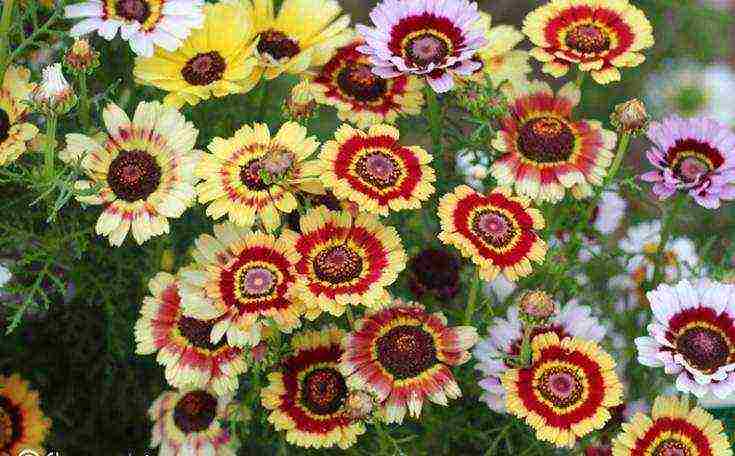
It turns out that there are some! They bloom in July and bloom continuously until frost, delighting us with bright simple, semi-double or double inflorescences-baskets. Unpretentious, withstand cold and drought. To start them in the garden, you need to sow seeds directly into the ground in May. An open, sunny place will be good for them, the soil is light, not waterlogged. Seedlings appear within a week, grow rapidly and bloom in late June - early July.
Most commonly grown species
Chrysanthemum prominent Large plant about 100 cm high with delicate foliage. Blooms in early July in large flowers (up to 11 cm in diameter). They can be double, like the Annette variety, and simple white with yellow "daisies".
Sowing chrysanthemum... A very unpretentious plant native to southern Europe. Stems are straight, slightly branched, about 60 cm high. Flowers are simple, yellow or white, varietal plants have additional color in the form of red tips of petals (Zebra variety) or red predominates (German flag variety). Long bloom - from June to October.
Chrysanthemum odorless... A variety called "Wedding Dress" is grown in the gardens. This is a low (20 cm) strongly branching bush, decorated with snow-white dense double flowers.
Chrysanthemum is scaphoid. The name was given because of the unusual type of seeds, similar to a boat with a keel, hence another name - keeled. The flowers of this species are the most elegant: reed petals with multi-colored stripes-rings are located around the flat dark center. Their colors are so diverse that a scaphoid chrysanthemum flower bed looks like an iridescent gem.
Chrysanthemumcrown. Tall, dense bushes are abundantly decorated with large flowers with yellow or white petals, often with dark centers. Often grown varieties "Nivea" with white flowers, "Orion", "Tetra Comets" - yellow.
The main advantage of chrysanthemums is their ability to bloom for a long time. They continue to delight the eye, even when all other plants have stopped growing. Therefore, flower growers always strive to find a place in their flower beds for these flowers.
Varieties and varieties of chrysanthemums
The varieties and varieties of chrysanthemums are extremely diverse. Early and late specimens, tall and border flowers seem to be created for the most demanding taste.
Garden chrysanthemum single-headed
Plant with one large inflorescence on a powerful tree-like stem. Most of the single-headed chrysanthemums are tall, large-flowered.
It is interesting that by competent and timely pinching it is possible to form a single-headed specimen from almost any variety of chrysanthemums.
Brief characteristics of single-headed varieties:
Anastasia
One of the most popular varieties of chrysanthemums. Differs in a rich palette of colors - white, green, yellow, pink, lilac. Large flowers with long needle-like petals reach 18 centimeters in diameter. Flowering begins in September, depending on the region, it can continue until the end of autumn.
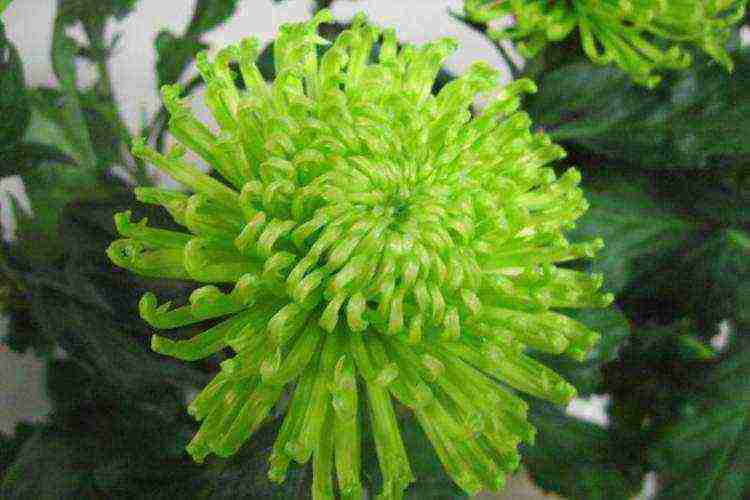
Zembla
Frost-hardy plant with large spherical white or yellow flowers. The Zembla cultivar is found both in a single-headed and in a bush version. It blooms in September, and with the seedling method of cultivation, the flowering time is shifted to the beginning of June.
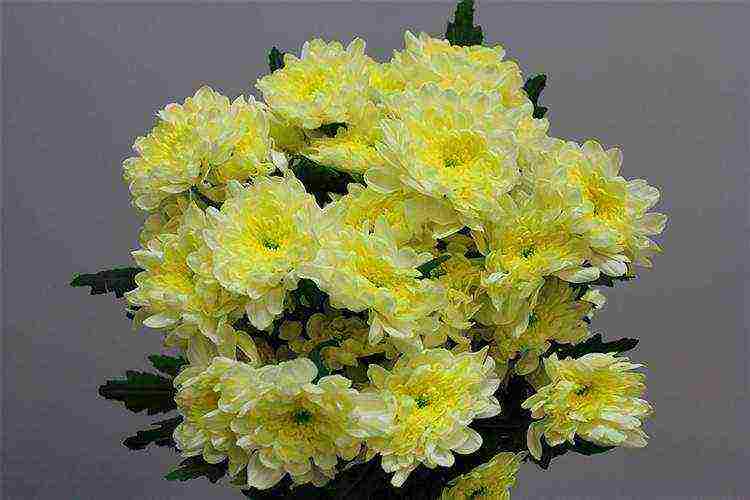
Shamrock
Single-headed chrysanthemum with a ball-shaped flower with a diameter of 10-12 centimeters. The color of the flower is green. The plant is up to 90 centimeters high.
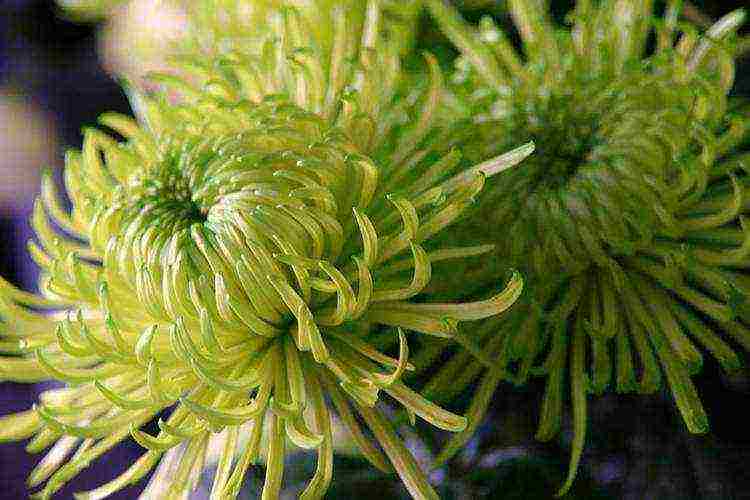
Inga
Semi-double variety with medium flowering time. The flower is yellow with a diameter of up to 10 centimeters. The shape of the inflorescence resembles a chamomile. The stem is up to 60 centimeters high.
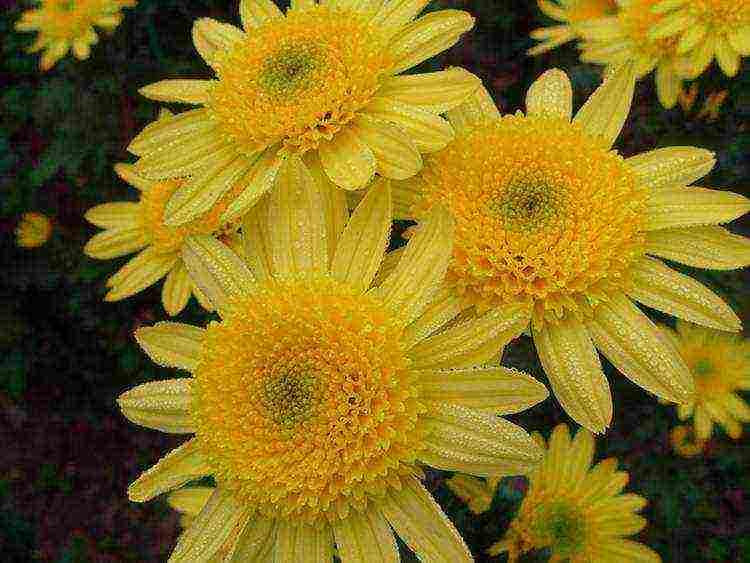
Regina White
A flower of white color with an average flowering period has the shape of a hemisphere. The stem height reaches 60 centimeters.
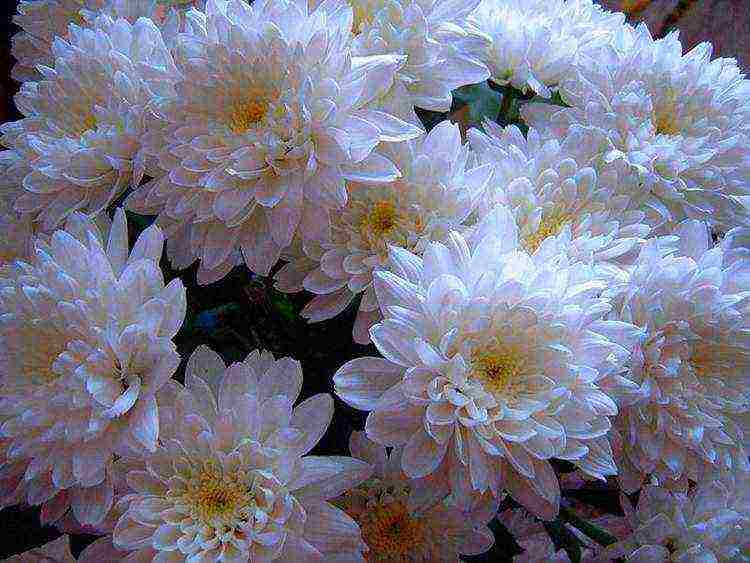
Chrysanthemum garden bush
Unlike single-headed flowers, bush chrysanthemums give a large number of inflorescences against a background of abundant greenery. They are well suited for garden decoration in late autumn. A large number of varieties allows you to combine plants in flower beds of different colors and quality of flowers.
Crown chrysanthemum
A variety with a yellow-green or white color. A large number of small flowers (3 centimeters in diameter) fold over the bush into a lush hat. Height can vary from 40 centimeters to one meter. Flowering is very long.

Bacardi
Refers to tall early varieties. Differs in persistence, very good in bouquets. The diameter of the bud is 6.5 centimeters. A white flower with an unfilled green core looks very delicate.

Saba
A medium-sized, unpretentious variety with a very ancient history. The bush reaches 70 centimeters. The flowers are unfilled, the core is velvety yellow-green. The reed petals are lilac, burgundy and lilac with white edging.
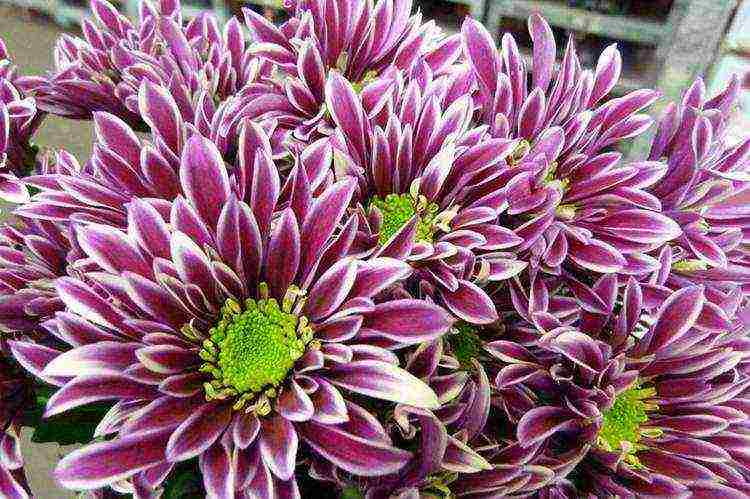
Baltic (bush Zembla)
It has large globular buds of a very wide palette of colors: white, pink, yellow and orange. Hardy, blooms until late autumn. It stands for a very long time.

Optimist
Small-flowered variety with unfilled inflorescences. It has a medium flowering period, but the life span of the flowers makes it decorative until late autumn. The core is light green with mauve petals. A very aromatic variety.

Small-flowered chrysanthemum, or Korean chrysanthemum
The most common variety in our country, which has received the popular nickname "oak" for the shape of the leaf. Their flowers are medium-sized - about 4-5 cm in diameter. They are distinguished by abundant and long flowering. These chrysanthemums do not require any shelter for the winter, they reproduce well by cuttings, they stand in bouquets for a long time.
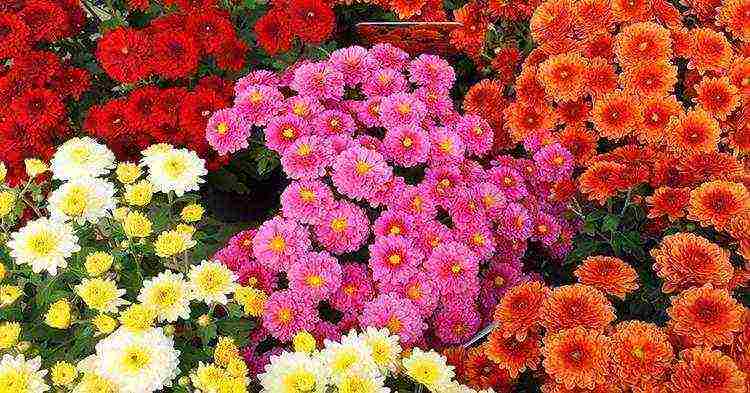
Chrysanthemum spray or multiflora
Globular chrysanthemums (multiflora) are the peak of garden fashion. They bloom at the end of August and bloom until the very frost. The bush does not need to be cut and pinched. Self-formation is a genetic property of the variety. The care is the same as for a regular chrysanthemum. The spherical chrysanthemum hibernates only in storage at above-zero temperatures.

In the middle lane, it is better to choose varieties for growing that bloom from July to October - low chrysanthemums of early or medium flowering periods. Late varieties will most likely have to be transplanted in a warm place to admire the flowers.
Dates for planting chrysanthemums in open ground
Chrysanthemums are preferably planted in spring. The earth should warm up to a depth of 15-20 centimeters to 12-14 ° С. In the Moscow region, central regions and Siberia, the time of planting chrysanthemums by seedlings falls on the first days of June. In southern Russia, this is done in early April, after the end of return frosts. For spring disembarkation procedures, it is better to choose a cloudy, cool day.
In autumn, it is recommended to plant until the end of September (in the south until mid-October), while the air temperature is not lower than 15-10 C.
If the autumn planting date is missed, you can plant the stalk of the plant you like in a container and, when it takes root, put it in a dark, cool place. It will definitely come in the spring.
Site preparation for planting
It is important to choose a suitable place for these flowers. It should be well warmed up by the sun and protected from drafts, they won't even like partial shade.
The soil for chrysanthemums needs fertile, rich in organic matter. Weakly decomposed high-moor peat, plant residues or rotted compost will be useful as a nutritious mulch. The acid balance should be neutral or slightly acidic. Light sandy loam soil is ideal, but some growers do well on loamy soil.
Chrysanthemums cannot stand stagnant water - their roots rot. Therefore, it is important to consider the drainage of the flower bed. For a better drainage of moisture, you can add coarse river sand to the ground. Box beds raised above the ground will be a good solution for these flowers.
In one place, they successfully grow up to five years. But you need to return them to the old flower bed only after two or three years.
Legumes, perennial grasses, and other garden plants with a one-year development cycle are suitable for them as predecessors. After flowers from the aster family, as well as solanaceous plants, it is better not to plant chrysanthemums.
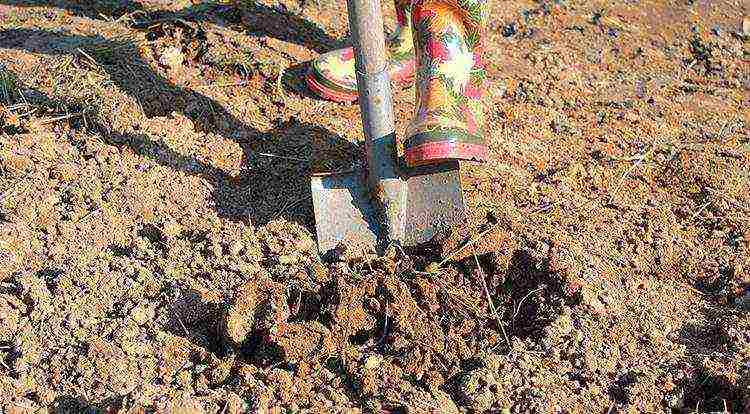
Prepare the site for planting in advance:
- in the fall, he dug to the depth of the bayonet of the shovel;
- apply mineral fertilizers - superphosphate and potassium salt at the rate of 50 g and 30 g per square meter;
- if required, the soil is chalked or acidified with wood ash;
- for the winter, the garden bed can be covered with a layer of foliage, which is dug up together with the soil in the spring;
- in the spring, the site is subjected to a secondary digging with the introduction of humus, some gardeners simply add it in portions to the ready-made holes.
How to plant chrysanthemums correctly
Chrysanthemums have a powerful root system that branches well and goes to a considerable depth. When planting, they must not be thickened.
The distance between the bushes depends on the variety:
- undersized curb varieties are planted at a distance of about 30 centimeters from each other;
- 40 centimeters distance for medium height flowers;
- for tall varieties, a distance of half a meter will be required, otherwise they will oppress each other.
A few hours before planting, seedlings are abundantly watered in a pot, so that it is easy to cross the rhizome along with a lump of earth.

Flowers are planted in separate holes 25 to 40 centimeters deep, depending on the variety and size of the seedling. The root collar must not be deepened more than two centimeters. Ideally, the base of the seedling root stem is at the same level as in the pot.
After planting, the flowers are watered abundantly, the soil is compacted, and the watering site is sprinkled with a thin layer of humus and covered for several days with non-woven material, protecting from the sun's rays. Tall stems are tied to pegs made of pine trees with a natural rope - twine or hemp.
To provide chrysanthemums with the best lighting when planting, they maintain a checkerboard pattern.
Chrysanthemum care
Complex measures for the care of these plants include:
- watering strictly to the root;
- weekly loosening with a little hilling of bushes;
- regular feeding;
- tying tall varieties;
- removal of old leaves and diseased shoots, pruning of excess growth.

Watering and feeding
During the period of active growth of the vegetative mass, plants need regular and abundant watering. In the future, watering should be carried out taking into account precipitation and alternating with loosening the soil.
Two weeks after planting, the seedlings can be fed with a solution of azophoska or ammonium nitrate at the rate of 20 g per 10 liters of water. Lack of nitrogen is fraught with chlorosis.
They are also fed with mullein or bird droppings in low concentration.
After the bush is formed, the plant will recover after pinching, potassium-phosphorus fertilizers should be applied (an aqueous solution of potassium salt or superphosphate in a ratio of one to ten).
Any dressing should be carried out in the morning in moist soil, avoiding contact with foliage. Fertilizers for young plants are applied in two stages before the buds begin to stain.
Experienced gardeners recommend stopping watering and feeding chrysanthemums at the stage of bud formation. Stress will provoke profuse flowering.
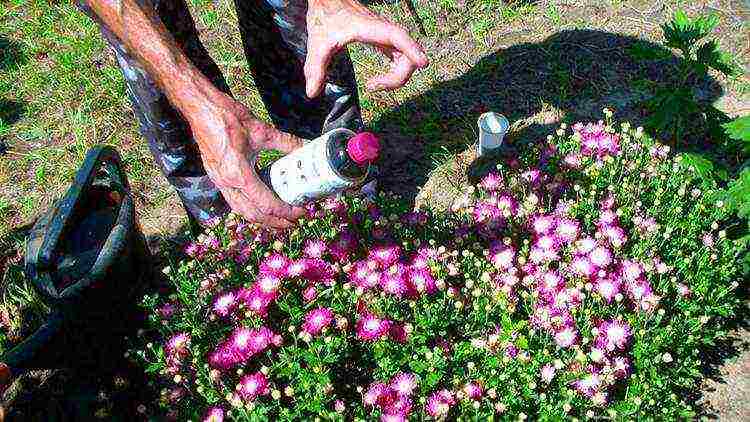
Grassing and the formation of single-headed flowers
In single-flowered chrysanthemums, pinching forms a powerful central stem, crowned with a single inflorescence. Lateral shoots developing from the leaf axils - stepchildren - are removed as early as possible, until the stem has hardened.
In addition to pinching, you should regularly pluck out excess buds. Inspection of the plant for the removal of lateral flowers should be carried out daily from July to August.
Pinching buds
This is the name of the procedure for choosing the strongest - the main bud and removing the excess.
Zero, the first bud appears before everyone else - immediately after planting the plant in the ground in May or June. It requires a lot of strength from the plant and slows down its development. Despite the fact that he himself is rarely large.
Then, on the lateral secondary shoot, the first crown bud begins to develop, which suppresses the development of an early spring flower. And on the third-order shoot, in turn, the second crown bud is already developing. Etc.
If all these buds are allowed to bloom, then the inflorescences will come out small, they will shade each other. The plant will bloom quickly.
It is believed that the largest flower is formed from the first or second crown bud. The gardener leaves one of them to his choice, deleting all the others.
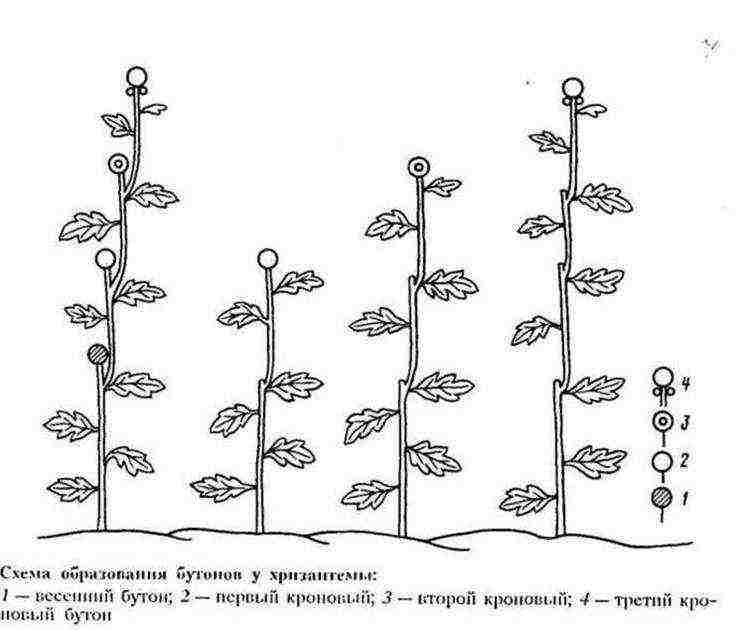
Correct pinching of bush chrysanthemum
Pinching - removal of the upper part of the shoot during the period of active growth of the bush before flowering. You need to pinch shoots that violate the natural or desired shape of the bush. Also remove early buds that appear before the time of general flowering.
The formation of chrysanthemums is carried out in several stages with a significant interval so that the plant has time to recover.Depending on the variety, breeding time and the choice of buds for flowering, a different number of pinches are carried out. The decision on their number is made based on the degree of branching of the bush: if the first pinching results in seven shoots, then this procedure can not be repeated again.

The strategy for pinching bushes is based on a variety of chrysanthemums:
- the shoots of mid-flowered plants are pinched when a bush of three to five shoots is formed and reaches a height of 10-12 centimeters;
- when forming small-flowered specimens with one pinch, remove the top of the central shoot above the tenth leaf;
- when forming in two pinches, first, the central shoot is shortened above the eighth leaf, the tops of the lateral shoots are pinched at the second stage above the fifth leaf;
- large-flowered varieties are pinched at a height of 10-15 centimeters, above the eighth leaf, the pinching is repeated on the side shoots when they reach 10-12 centimeters.
Timely pinching contributes to the rapid growth of lateral shoots and the normal development of buds. The last pinching is recommended to be done no later than two and a half months before flowering.
The regularity of the need for pinching, depending on the flowering time of the variety:
- early varieties of chrysanthemums are pinched once or twice;
- with late grafting, they can be grown without pinching;
- medium and late varieties sometimes have to be pinched up to three times;
- the later the grafting was carried out, the less pinching will be required;
- undersized varieties with a compact bush shape are pinched only once.
In other words, the more time elapses between planting a plant in the ground and the beginning of flowering, the more excess greenery and buds are formed, which should be removed.
Pinching of spray chrysanthemums is carried out similarly to single-headed chrysanthemums. The strongest on them are the second crown buds, which are formed after repeated pinching.
If you leave up to three or four shoots on the bush, removing all but one of the buds from each, the flowers will be much larger.
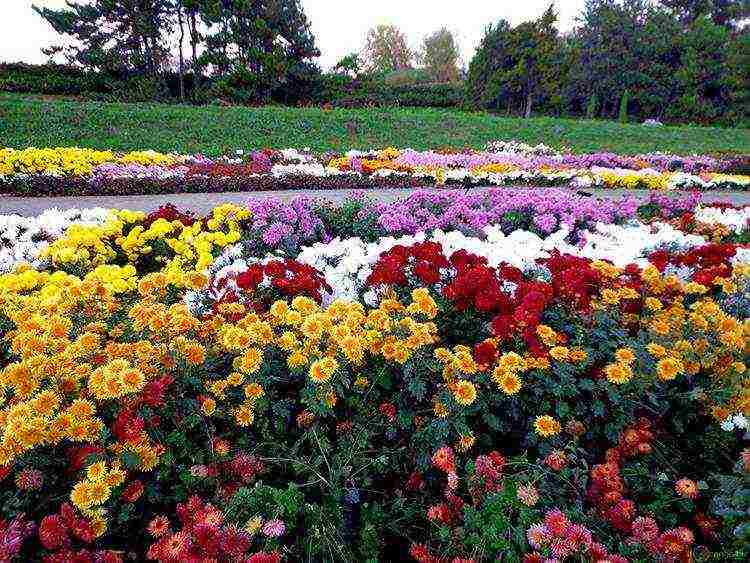
Dependence of the beginning of flowering on the length of daylight hours
Chrysanthemums are short-day plants. They develop a green mass between April and August, when the night is shorter than the day. Gradually, this process slows down in accordance with the natural cycle.
When the daylight hours are reduced, buds are laid. Accordingly, the earlier the short day comes, the faster these plants will form buds. Chrysanthemums usually bloom from August to December, when the dark prevails.
In greenhouse conditions, this feature makes it possible to artificially provoke flowering.
How you can speed up flowering by shading
Many gardeners have adapted to shading outdoor flowers in order to induce early flowering. To do this, chrysanthemum bushes from the beginning of August begin to shade in the morning and evening hours so that they have a day of light for ten hours.
Shading should be done very carefully so as not to damage fragile stems. On the sides of the flower beds, stakes are installed in such a way that they are higher than the bushes. A dense dark opaque material is pulled on the stakes or covered with cardboard boxes on top.
Post-flowering care
The main rule for caring for a blooming chrysanthemum is that faded flowers must be carefully cut off, without leaving them to dry on the bush. This will provide the plant with better ventilation and protect it from possible infections that can develop in the wilted tissues of the inflorescence.
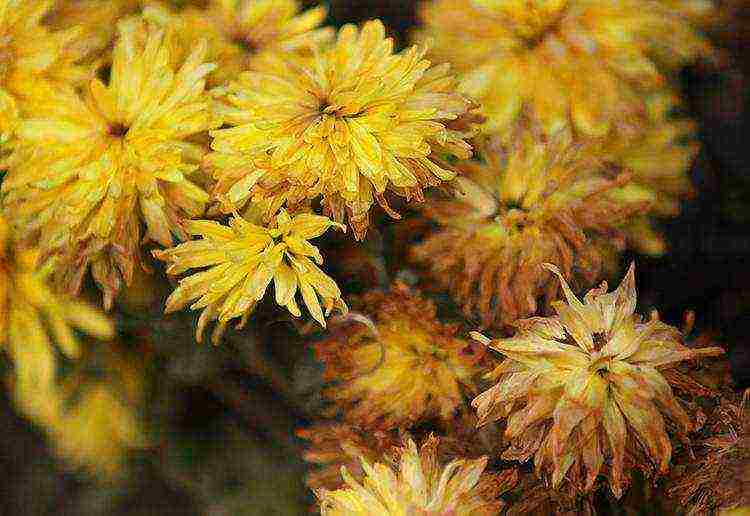
Cutting flowers into bouquets is only welcome, it has a beneficial effect on the quality of subsequent flowering.
Immediately after flowering, the chrysanthemum is pruned by about one third.
If the flowering is over before frost, then the plant, which remains in the garden until spring, can be fed with organic matter so that new strong shoots are formed, as a guarantee of a successful wintering.
For chrysanthemums hibernating in pots, such support will be a nutritious soil for transplanting.
Storing chrysanthemum roots in winter
The shelter time of chrysanthemums for winter storage is individual for each variety and climatic zone.
At the end of flowering, the stems must be cut off, the bush must be covered with earth and covered with spruce branches. And then cover the top with cellophane or tarpaulin. Experienced gardeners do not recommend covering them tightly with fallen leaves.
In the spring, additional protection is removed to avoid infection of the bush or damping off.
With proper shelter, Korean and other frost-resistant varieties of chrysanthemums winter safely in the ground, even in the middle lane.
If you cut the bushes too short, then they do not have time to lay the root rosettes and will die during the winter. When cutting, it is advisable to leave a third of the stems. It is better to leave the shoots formed around the bush in the fall. The enlarged root system will make the plant stronger during the wintering period and will become a kind of reserve in case some of the bushes freeze out.
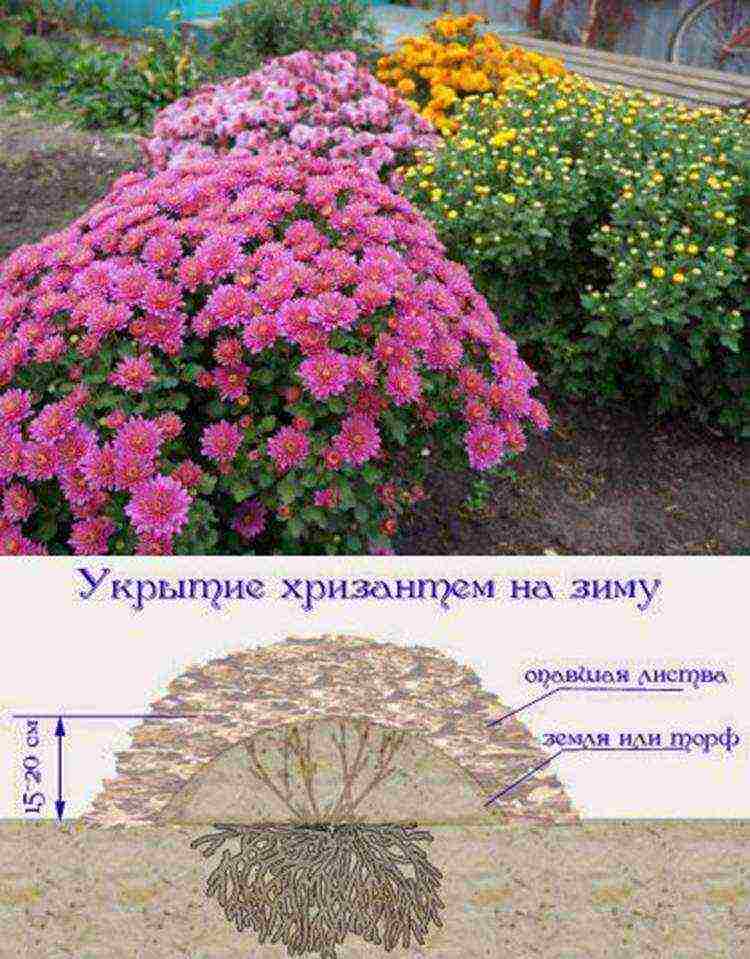
Heat-loving varieties for the winter are recommended to be dug up. And having transplanted them into boxes with fertile soil, send them to wintering in closed, frost-free rooms with low temperatures.
If the bushes did not have time to bloom, they can not be cut off and transferred to the veranda or greenhouse until the flowering ends.
Cut off bushes for winter storage in the same way as those that hibernate in the ground.
The room temperature should be lowered gradually. If it is still not cold enough there and the plants have sprouted, they must be re-pruned to 10-15 centimeters.
With occasional watering, chrysanthemums winter at temperatures up to 0 C. In the spring they are transferred to the light (a greenhouse or veranda is suitable) and begin to prepare for the next season in the open field.
Reproduction
Chrysanthemums reproduce by dividing the bush or by cuttings.
It is best to divide the bush in the spring. This should be done about once every three to four years. It is dug out carefully so as not to damage the roots. Divided into separate branches and planted. If everything is done correctly, the delenki will quickly take root and will give the first flowering in the same year.
Cutting can be carried out all year round, but it is especially effective in spring or early summer. Cuttings are cut about 10 centimeters long from shoots with green, unhardened bark. The lower leaves are removed from them and placed in water, or planted under a film, subject to abundant watering. The cuttings take root within a couple of weeks.
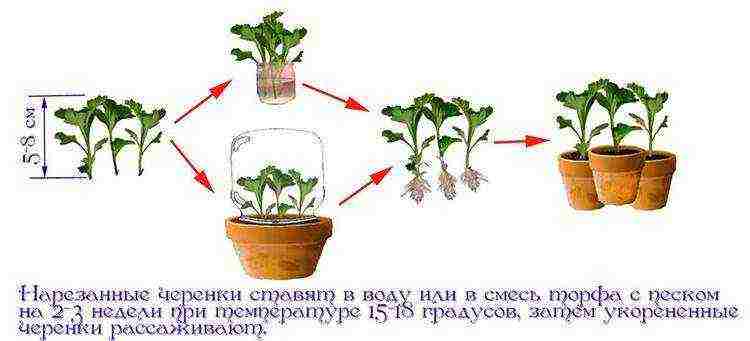
When buying chrysanthemums for planting in the form of seedlings (at the beginning or end of May) or rooted cuttings for subsequent growing (March-April), special attention should be paid to information about the conditions under which the planting material was grown. Even the most beautiful greenhouse seedlings or cuttings will not give the expected result outdoors. It is better to give preference to nondescript hardened specimens.
You can grow this flower from seeds - a way for those who are not looking for easy ways. Seeds are harvested from dried flowers, and sowing begins in early spring. Naturally, this can only be done in greenhouse conditions. Seeds are sown on top of wet soil and left in the light. The sprouts will appear in about ten days. When they get stronger, you can transfer them to open ground. At first, young sprouts must be shaded with agrofibre. In the first year of the growing season, such chrysanthemums will not bloom, but if single flowers appear, then they must be removed.
Diseases and pests
Slugs, aphids, thrips, spider mites and caterpillars are considered enemies of chrysanthemums. Plants are especially vulnerable during the wintering period, when pests seek to hide in a bush.
Chrysanthemums are susceptible to viral and fungal diseases such as rust, powdery mildew, gray rot, and verticillary wilting.
- Gray rot is a fungal disease in the form of spots of brown and gray color, affecting the aerial parts of plants.
- Powdery mildew appears as a white coating on leaves and inflorescences.
- Verticillium wilting is a fungus that penetrates the roots of a plant and leads to the death of leaves and whole shoots.
- The most serious danger among viral diseases is the nematode. A sign of damage to a flower by a nematode is blackening of the lower leaves.
Viral diseases such as dwarfism, mosaic, aspermia, deforming leaves and flowers of chrysanthemums, leading to a delay in development, are incurable. If the diagnosis is correct, then the affected plant remains to be dug up and burned. And it is not recommended to plant new chrysanthemums in this place for several years.
Prevention of chrysanthemum diseases:
- compliance with the rules of crop rotation;
- correct fit without thickening;
- proper care with the removal of dead plant parts;
- disinfection of soil, places of winter storage;
- purchase of high-quality planting material.
Preventive measures can also include the use of insecticidal and disinfecting agents of natural origin. Such as red pepper, tobacco dust or wood ash. If there are pronounced signs of a disease or pests are found on the bushes, it is better to resort to heavy chemistry (Bordeaux liquid, copper oxychloride).
You can not start diseases and continue to cultivate affected plants.
The agrotechnology of growing these flowers is understandable and accessible to everyone. They, just like other garden dwellers, require a little labor and attention, for which they pay with generous and long flowering.
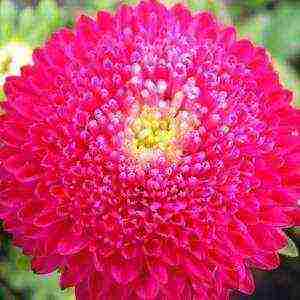 Blooming garden decorations are a favorite theme for any modern gardener. New varieties of beautiful flowers are constantly appearing that can decorate any flower garden and rockery.
Blooming garden decorations are a favorite theme for any modern gardener. New varieties of beautiful flowers are constantly appearing that can decorate any flower garden and rockery.
This page offers a small catalog of new species and varieties of chrysanthemums with names and photos. It features such types of flowering plants as cut chrysanthemums; perennial and annual flowers, white chrysanthemums, globular, and even single-headed. Also, Korean types of chrysanthemums, white and new varieties of this plant will be described.
It is impossible to describe and disclose all the names of varieties and types of chrysanthemums in this article, so only the main, most common, as well as the most amazing and attractive in appearance will be affected.
Each plant variety will be characterized in terms of the shade of the inflorescences, their shape, diameter, as well as the time when they begin to bloom, the size of the shrubs in general will be considered. All varieties of chrysanthemums are accompanied by photos that show the richness of color and a variety of bud shapes: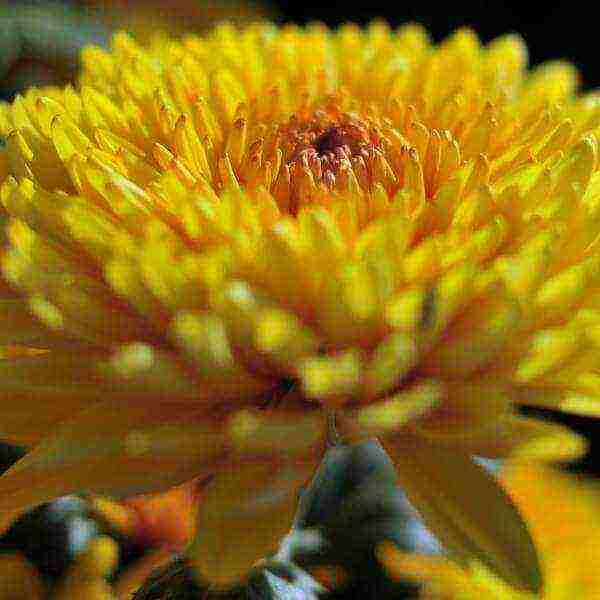
Large-flowered cut chrysanthemums: varieties that allow you to create bouquets
Bouquet forms of flowering plants are a great opportunity to decorate your home and please your loved ones with an excellent gift. Cultivars that can create sophisticated bouquets include varieties that have a fairly long stem and a compact arrangement of buds at their tops. For cutting, Indian varieties of chrysanthemums, or, as they are called in another way, large-flowered, are most suitable.
Indian chrysanthemums are usually grown indoors. These plants bloom in late autumn and are used for perspective cutting. Subject to certain agricultural techniques, large-flowered chrysanthemums for cutting can be grown in a garden plot in a seedling way.
Variety "Gazell".
The flowers are hemispherical. Large in size, terry, snow-white shade. The diameter of the flower reaches 12-14 centimeters.
Leaves are medium in size, light green in color, rarely located on the stem.
The color begins to bloom in mid-August.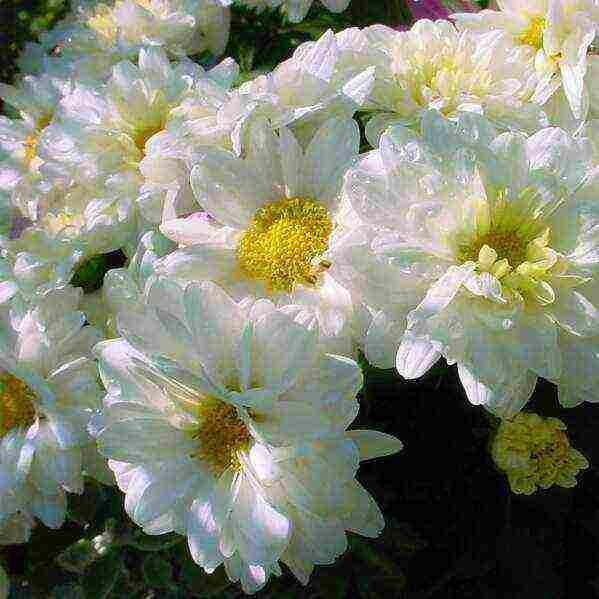
Variety "Valentina Tereshkova".
This chrysanthemum variety was bred in the Crimea.
The leaves of the plant are large in size.
The upper part of the petals is red-crimson, and the lower part is a lighter shade.
Begins to bloom in the first half of September.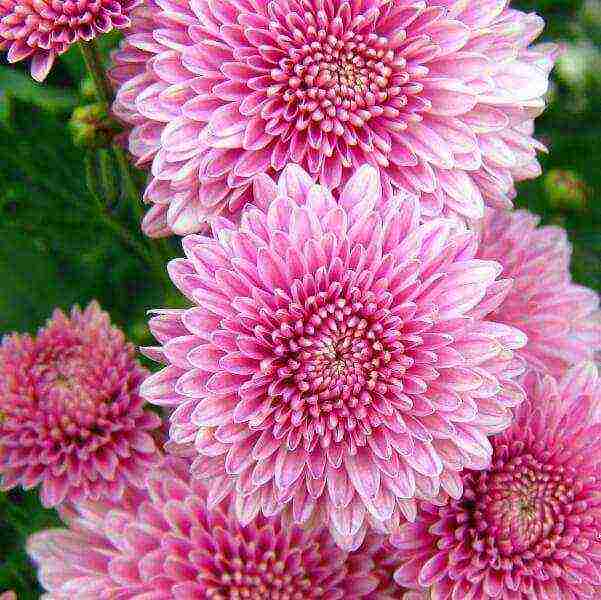

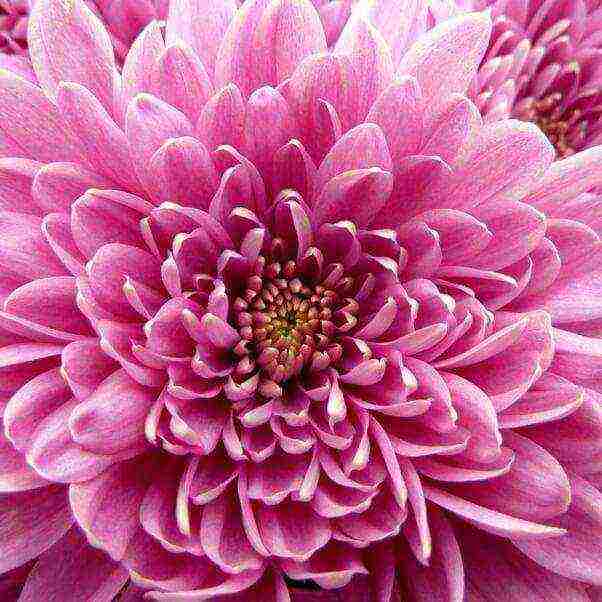
Variety "Alec Bedser".
The plant grows in length up to 65-70 centimeters.
The flowers are hemispherical, cream-colored, 13-14 centimeters in diameter.
The flowering period is September-October.
Perennial and annual chrysanthemums: varieties and their photos
Perennial chrysanthemum varieties include all types described in this catalog, with the exception of those that are annual. These plants are distinguished by their ability to give excellent flowering for 3 or more years without transplanting and rejuvenating the bush. They are usually used to decorate flower beds and flower beds in the landscape design of a personal plot, in park areas.
Among the currently selected and widely used species of annual chrysanthemums, there are several varieties that are distinguished by resistance to adverse environmental conditions. Next, you can see annual and perennial varieties of chrysanthemums in the photo and evaluate their attractiveness for growing:

Tricolor chrysanthemum.
This plant variety reaches a length of sixty centimeters.
The leaves are thick, gray-green in color.
The diameter of the inflorescence is four to six centimeters.
Varieties:
- Flammenstahl This flower has a yellow-brown heart and red petals.
- "Nordstern" This is a rather large flower of snow-white color with a yellow-red center.
- "Cockard" This variety is a snow-white flower with a carmine base. Blooms in June-September.
Sowing (field) chrysanthemum.
The sown chrysanthemum grows in length up to thirty to sixty centimeters.
The leaves are pinnate below, and serrated above.
Flowers are associated with large daisies. They have light or dark flat middle, their color is snow-white, gray-yellow or pure yellow. The diameter of the flowers is three to five centimeters.

Crowned (crowned) chrysanthemum.
Crown chrysanthemum in height reaches forty centimeters to one meter.
The leaves are pinnate, somewhere pointed.
The flowers are three centimeters in diameter. The lingual form of the flowers has a yellow or white tint, and the tubular flowers have a greenish-yellow tint.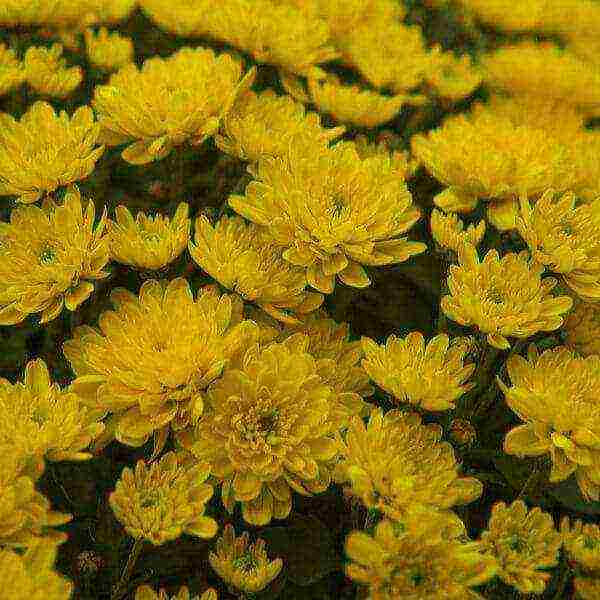
Spherical garden varieties of chrysanthemums with names and photos
To add variety to the flower palette of the garden, you can use several varieties of the same botanical group at the same time. At the same time, the gardener gets an undoubted advantage, since the care is the same, and the result pleases the eye with its diversity and duration of flowering. Spherical varieties of chrysanthemums allow you to get beautiful and large buds with different colors of petals. Garden varieties of chrysanthemums with photos and recognitions of globular types are shown below.
Chrysanthemum "Ida".
It is a bush in the shape of a ball, up to sixty centimeters long, and the flower diameter is three centimeters.
Blooms in late September - early October.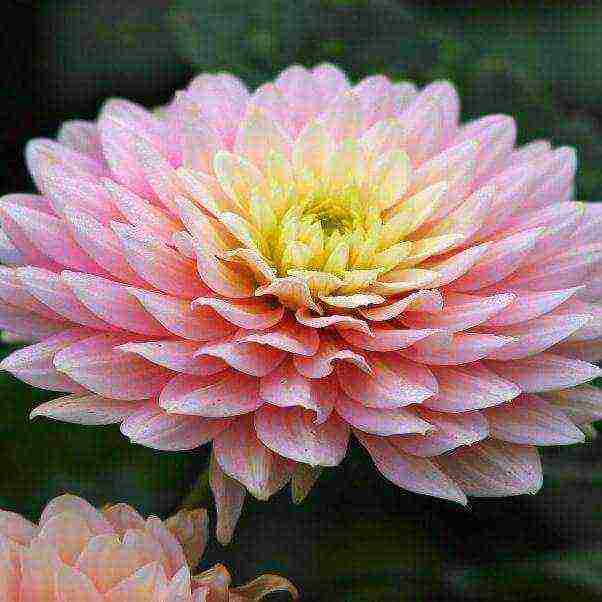
Knop.
The flowers of this plant are yellow, in the form of a pompom, up to three centimeters in diameter.
The bush reaches a height of thirty-five centimeters.
It starts to bloom in October.
It blooms profusely, namely, up to 160 flowers at a time.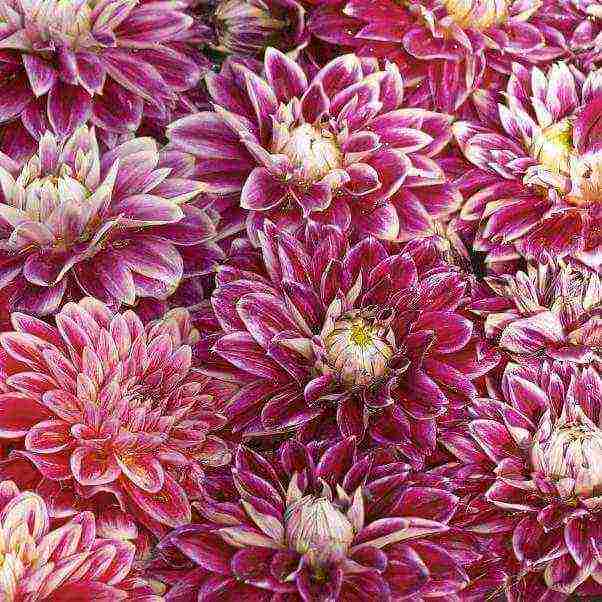
Chrysanthemum "Multiflora".
This type of chrysanthemum has a spherical bush shape.
Blooms profusely.
The color range of flowers is extensive: white, yellow, orange, pink, plum, red.
The flowers are small.
The color starts up in the month of September.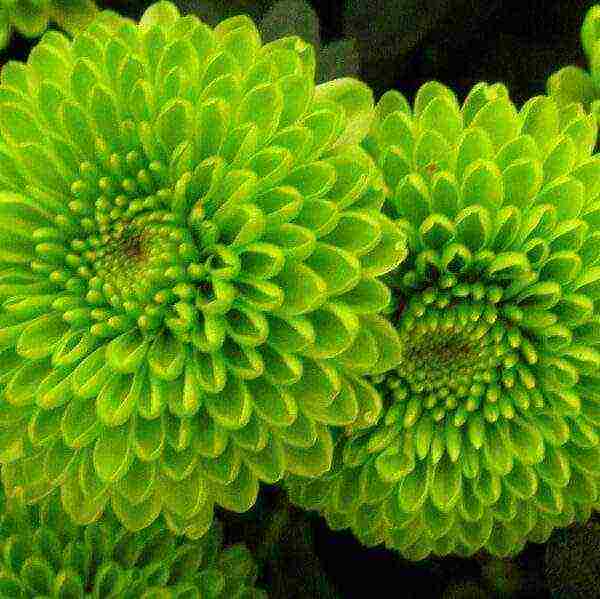
Korean chrysanthemums - placers of small inflorescences
Representatives from the group of varieties of Korean chrysanthemums are a great decoration for landscaping a garden, making bouquets or landscaping the interior of a country house. These varieties differ in long, and in protected ground, almost continuous, flowering. Bright colors and excellent decorative properties of soft, slightly pubescent foliage prevail. These are small-flowered chrysanthemums, placers of small inflorescences of which can be seen further with names and photos: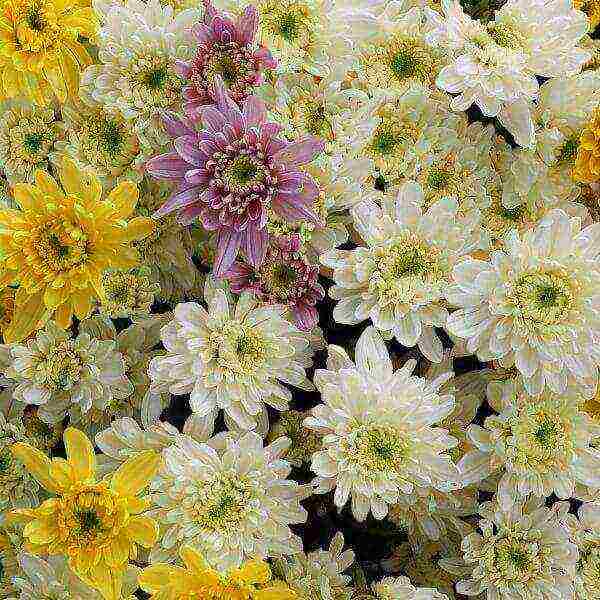
"Vivat Botaniku".
The bush reaches a height of fifty-three centimeters, and thirty-five centimeters in diameter.
The leaves are green in color.
The flowers are semi-double, their diameter is six to seven centimeters, and they are yellow. They have a pleasant smell.
Blooms profusely, period - 62 days, from mid-August.
"Dune".
The height of the bush is about fifty centimeters.
Flowers up to seven centimeters in diameter, yellow-brown in color.
The color of the inflorescences changes as it blooms - the buds are crimson, when the flower blooms, the color changes from orange-brown to golden yellow.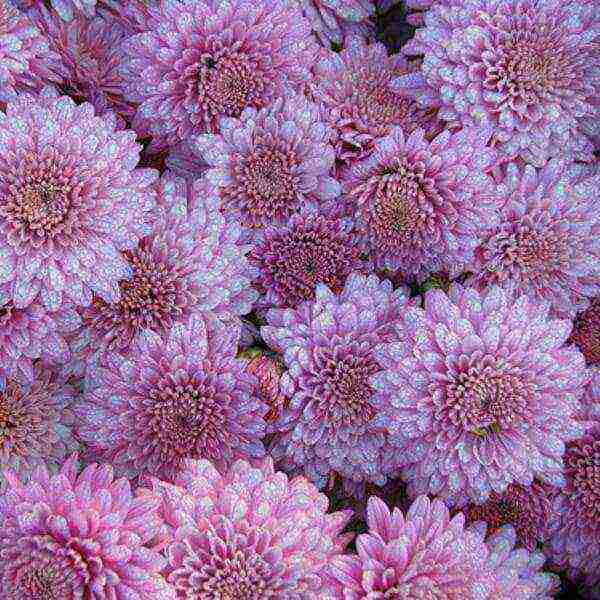
"Kibalchish boy".
The height of the bush reaches approximately fifty centimeters, and the diameter of the flower is five centimeters.
The inflorescences have a rich red tint.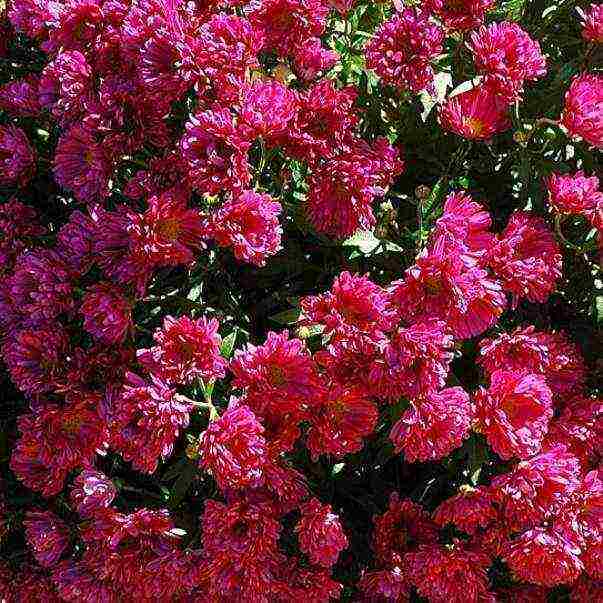
"Altyn Ai"
The plant reaches a height of 50-57 centimeters, and a width of 47 centimeters.
The leaves are dark green in color.
Terry flowers, up to eight centimeters in diameter, yellow in color. Fragrant.
This variety blooms for 66 days, starting in mid-August.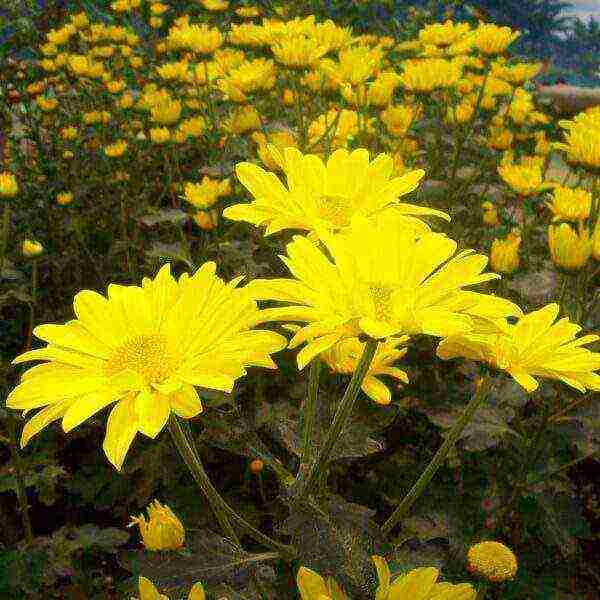
Single-headed large-flowered varieties of garden chrysanthemums (with photo)
A real miracle from the world of flora is the single-headed chrysanthemum, the varieties of which can be found further on this page. Using such varieties, you can create bright accents and stylistic spots in flower beds and flower beds. Such cultivars can be grown as varieties for bouquet cut. All large-flowered varieties of garden chrysanthemums are accompanied by photos that illustrate the richness of shades and colors: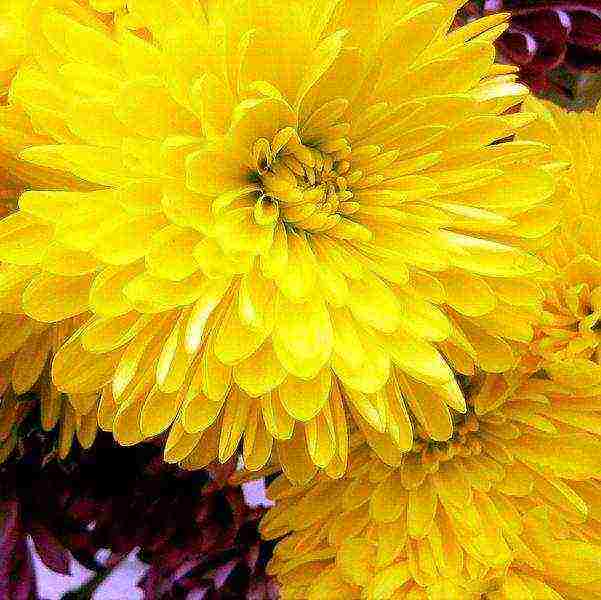
"Shamrock"
The bush is shaped like a ball.
The shape of the flower is unusual: long needle-shaped petals look up to the center, and in the center they tightly surround the core so that it is not visible.
The flower is green in color. The diameter reaches ten to twelve centimeters.
The stem of the flower reaches seventy to eighty centimeters.
Leaves are green.
In a cut-off vase, they can last up to twenty days.
The variety is fragrant.
"Inga"
Has the shape of a chamomile, semi-double.
The core of the flower is rounded with a large number of short petals that have not opened, and the outer petals are arranged in one row and slightly elongated.
The opened flower has a bright yellow hue, its diameter is up to nine to ten centimeters. Fragrant.
The stem of the flower reaches sixty to seventy centimeters in length.
Leaves are bright green.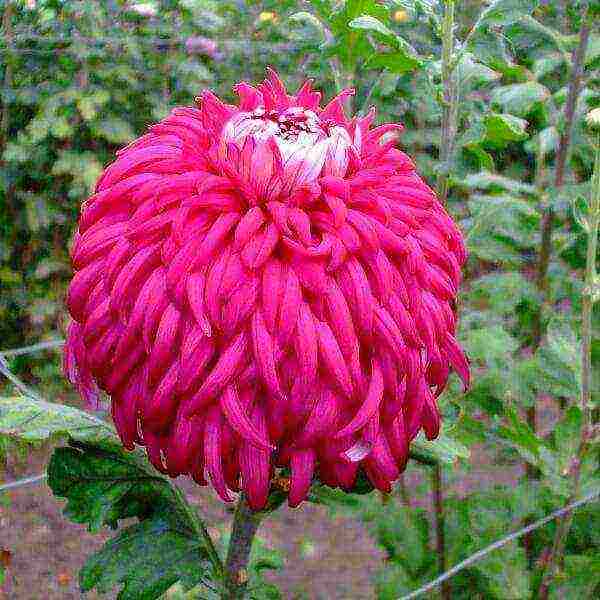
"Regina White"
The flower has the shape of a hemisphere, double.
The petals of the flower are elongated, bent upward, and in the central part they tightly surround the core. The outer petals are spread apart.
The opened flower has a snow-white color, its diameter is ten centimeters. Has a scent.
The stem of the flower is sixty to seventy centimeters.
Leaves are rich green.
White varieties of chrysanthemums - exquisite freshness and purity
Garden varieties of these flowering plants would be orphaned, if not to mention the cultivars with pure white color of petals of buds of various shapes. White varieties of chrysanthemums embody a real dream, this is a real refined purity and freshness that you want to touch, smell and admire endlessly.
"White Korean"
The bush of this plant is tall.
The flower reaches a diameter of up to eight centimeters. Its petals are slightly curved, silvery-white.
The color starts up from September until the beginning of frost.
"Snow White"
Plant height 25-30 centimeters, undersized.
The diameter of the flower is approximately three centimeters.
The bushes are spherical in shape.
Flowers resemble chamomile, their flowering period is late June - mid-autumn.
"Eleanor the White"
This variety is an anemic type of flower.
The flower is up to 15 centimeters in diameter, white, yellow or pink.
When cut, it can stand in a vase for up to two weeks.
Evelyn Bush
The flowers have a snow-white shade, hemispherical shape, 12-14 centimeters in diameter.
The height of the plant as a whole reaches approximately one and a half meters.
Leaves are medium in size, dark green in color.
Early varieties of chrysanthemums with names and photos for growing in the garden
When spring comes, we rejoice at the first emerald greenery and a simple bud of primroses, which must be planted in your garden. But I really want a riot of colors and exquisite charm of a mixture of spicy aromas. Early varieties of chrysanthemums for growing in the garden in a seedling way help to get all this. It is recommended to plant them on seedlings as early as possible, as soon as daylight hours begin to reach 9 hours. This is usually the beginning - mid-February. With such a sowing time, flowering bushes can be obtained in the second half of May. It is worth noting that it is impossible to plant directly into open ground. It is necessary to harden for 10 - 15 days. Well, by the time of disembarkation, the spring return frosts should have completely passed.
The following are the most popular new early varieties of chrysanthemums with names and photos:
"Zembla yellow"
The flowers are yellow, large in size, spherical in shape, their diameter is fifteen centimeters.
It blooms in September, and with the seedling method of cultivation, the flowering time is shifted to the beginning of June.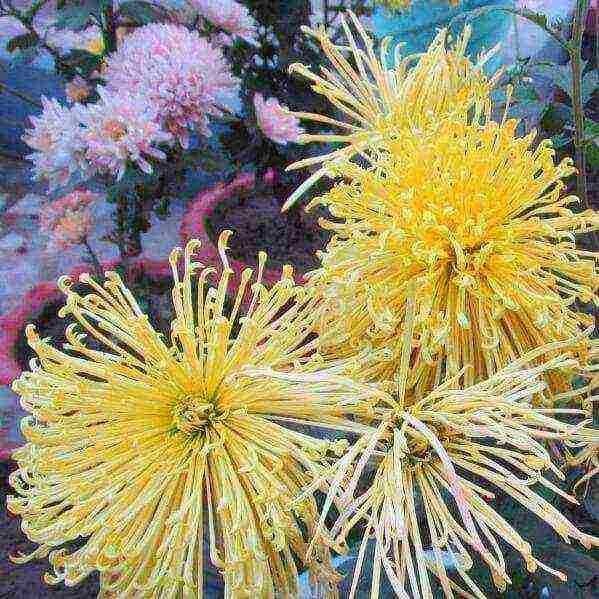
"Handsom"
This plant looks like a chamomile. It has a lilac color with a white border.
It starts blooming in September; with the seedling method of growing, the first buds are tied at the end of May ..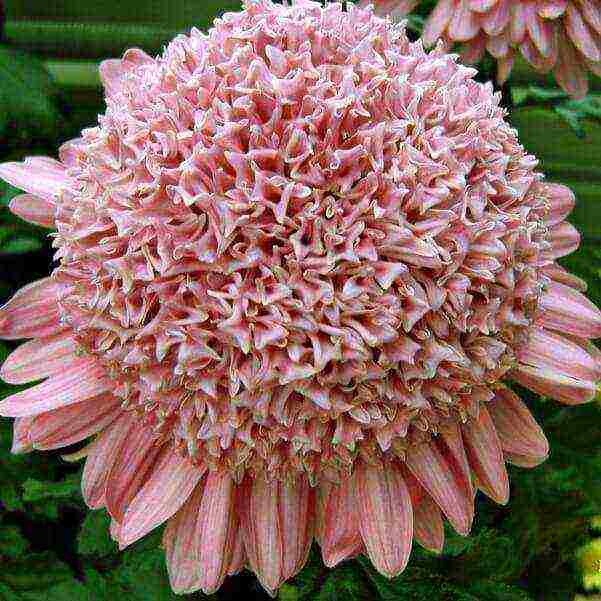
"Stern des Orients"
The peculiarity of this variety of chrysanthemum is its light yellow petals and dark core. Flowering begins in mid-June and lasts until the first frost in the fall.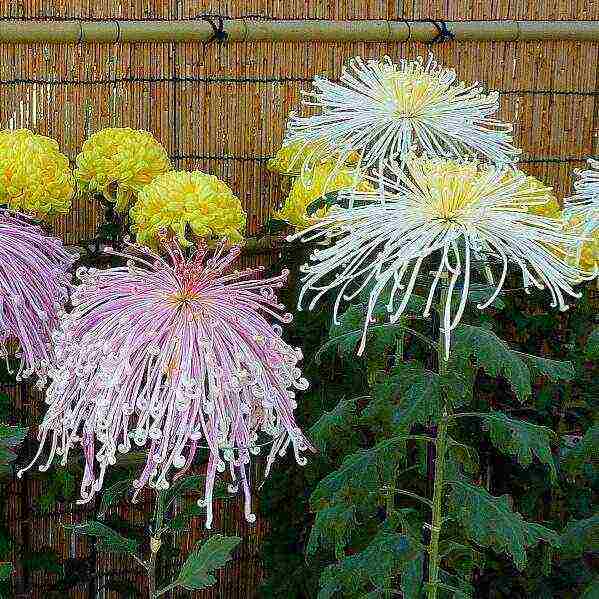
Garden varieties of chrysanthemums in the catalog with names and photos
Further, the catalog offers new garden varieties of chrysanthemums with photos and names, by which you can easily form your own collection of flowers for the upcoming season.
Pom-pom garden varieties of chrysanthemums have magnificent double, rounded inflorescences.
The feathery ones allow you to get double flowers, the core is not visible, since the petals hide them.
Bristly similar to feathery chrysanthemums, only the petals are thinner, sometimes curved. Flowers are associated with a brush, hence the name of this species.
"Stellini"
The flower of this variety is very similar to chamomile. The name is derived from the Italian word "stella", which means "star". The long petals of the flower are like an asterisk.
The flowers have a combination of purple and white, and the core is green.
Equator
The flower has a yellow color, a variety of single-headed chrysanthemum.
The flower is large in size.
=
Chrysanthemum is a plant that adorns many garden, backyard and summer cottages, front gardens. This flower pleases the eye from mid-summer to autumn frosts. It does not create any special problems in leaving. There are many varieties of chrysanthemums. And sometimes even experienced gardeners find it difficult to dwell on a specific variety. What is bush chrysanthemum, which variety should be given preference, how to grow and maintain a crop in good condition - the article will tell about all this.
how to grow and maintain a crop in good condition - the article will tell about all this.
Characteristics of bush chrysanthemum
 Chrysanthemum is a bush garden perennial plant with a height of 15 centimeters to 1.5 meters. Shrub chrysanthemums in flower beds appeared relatively recently, about 200 years ago. Their feature lies in their compact size. In a pot, the height does not exceed 50 centimeters. Height adjustable by pinching the top. Accuracy is given by removing the lateral processes. At first, the flower baskets looked like daisies: the petals are white and the middle is yellow. However, thanks to selection, other variations have appeared. For example, there is a red, snow-white chrysanthemum. Green bush and yellow chrysanthemums look unusual. See the article on growing garden gladioli.
Chrysanthemum is a bush garden perennial plant with a height of 15 centimeters to 1.5 meters. Shrub chrysanthemums in flower beds appeared relatively recently, about 200 years ago. Their feature lies in their compact size. In a pot, the height does not exceed 50 centimeters. Height adjustable by pinching the top. Accuracy is given by removing the lateral processes. At first, the flower baskets looked like daisies: the petals are white and the middle is yellow. However, thanks to selection, other variations have appeared. For example, there is a red, snow-white chrysanthemum. Green bush and yellow chrysanthemums look unusual. See the article on growing garden gladioli.
What types are there?
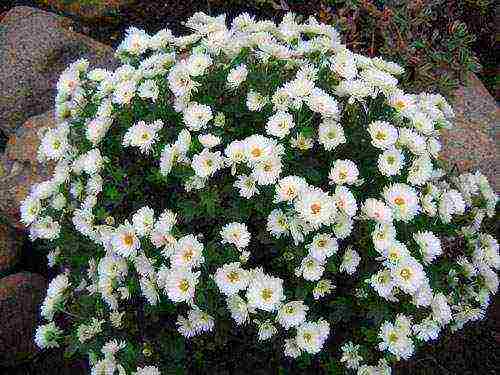 Many varieties of chrysanthemums are known. And according to some signs and characteristics, they are combined into groups. Let's consider the classification in more detail.
Many varieties of chrysanthemums are known. And according to some signs and characteristics, they are combined into groups. Let's consider the classification in more detail.
By the size of inflorescences, chrysanthemums are small, medium and large. Small-flowered are also called Korean. They are presented in double and simple specimens. A large number of buds are formed on one shrub, which, when opened, have a diameter of 2 to 10 centimeters. The height of the bush is 25-120 centimeters. The foliage looks like oak leaves. The varieties included in this group are distinguished by resistance to frost, unpretentiousness to the composition of the soil, and ease of maintenance. Small variants begin to bloom in the middle of September and delight with beauty until frost. Talisman, Barbarian and Evening Lights are popular.
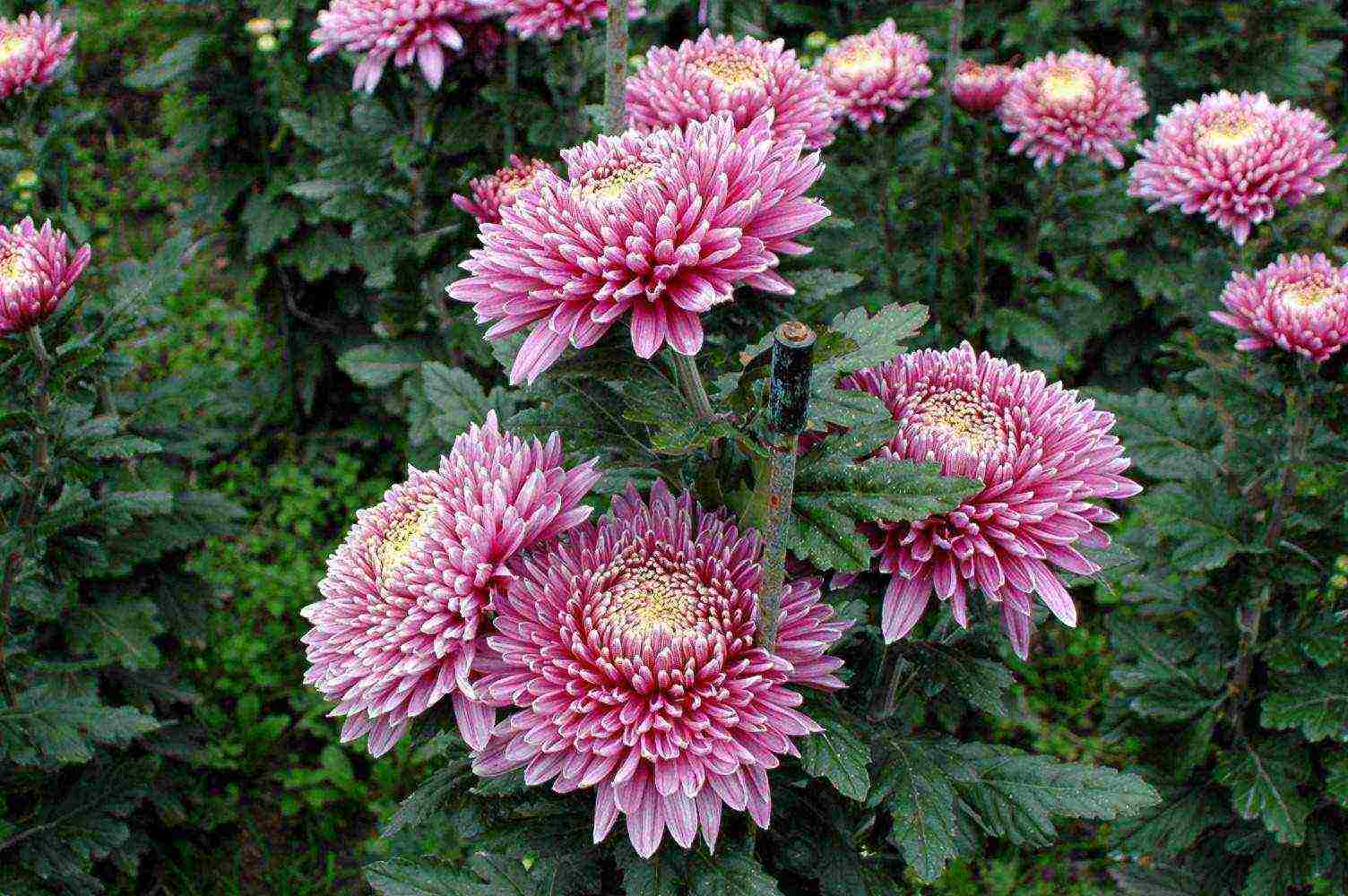 Medium-flowered are intended for decoration of garden plots. They are grown for cutting. Such a bush chrysanthemum in a pot on a windowsill also feels great and looks attractive. Loggias, balconies, terraces are often decorated with varieties of such plants. The culture reaches 30-70 centimeters in height. The diameter of the opened bud varies from 10 to 18 centimeters. The best medium-sized chrysanthemums are Dawn, Lilia and Dune.
Medium-flowered are intended for decoration of garden plots. They are grown for cutting. Such a bush chrysanthemum in a pot on a windowsill also feels great and looks attractive. Loggias, balconies, terraces are often decorated with varieties of such plants. The culture reaches 30-70 centimeters in height. The diameter of the opened bud varies from 10 to 18 centimeters. The best medium-sized chrysanthemums are Dawn, Lilia and Dune.
The most spectacular chrysanthemum is a bush perennial large-flowered. The stem length sometimes reaches 1.2 meters. The plant forms large inflorescences with a diameter of 10 to 25 centimeters. This species does not tolerate frost well. However, some varieties are capable of wintering in unprotected open ground. Large chrysanthemums are grown for cutting and creating bouquet compositions. They can also be used for hedges. The most popular are such varieties as Rosetta's Daughter, Umka.
 According to the shape of the inflorescence, garden bush chrysanthemums are divided into the following types:
According to the shape of the inflorescence, garden bush chrysanthemums are divided into the following types:
- Pompom. The tongue-shaped petals are collected in a ball that resembles a pompom.
- Anemoid. The buds consist of large petals, gathered in one to three rows. The flowers themselves are small in size. Double-row and single-row ones are bordered by flowers that look like tongues.
- Semi-double. Consists of 3 rows of reeds, which are located around the central bud.
- Terry. They stand out for their splendor, variety of forms and types.
There are annual and perennial varieties. Annual variants are represented by the following types: crowned, keeled, prominent, sown. The main perennial varieties include white bush chrysanthemum, large. For outdoor cultivation, varieties that are resistant to diseases, pests, weather and climatic conditions are usually used. Chrysanthemums of Indian origin are cultivated in greenhouses. They are great for cutting.
Which variety should a novice gardener choose?
A large number of chrysanthemum varieties are known. All of them differ in stem height, shape, bud color. Therefore, everyone can choose the most suitable option. For example, by choosing pink chrysanthemums, the garden will look elegant and gentle. However, to make it easier to decide on a specific variety, you need to understand the characteristics of the most popular plants.
It makes sense for a novice florist to pay attention to the following chrysanthemums:
 Bacardi. Belongs to the category of one-flowered. The color of the buds is often pearl white. But there is also a yellow bush and pink chrysanthemum. The stem is firm and strong. Therefore, with the help of this variety, it is really possible to create various flower arrangements. Cut crops retain their attractive appearance for a long time. The buds are quite strong, their diameter is 6.5 centimeters. This variety is the embodiment of practicality, elegance and durability. To create light, romantic bouquets, Bacardi bush chrysanthemum is the best choice.
Bacardi. Belongs to the category of one-flowered. The color of the buds is often pearl white. But there is also a yellow bush and pink chrysanthemum. The stem is firm and strong. Therefore, with the help of this variety, it is really possible to create various flower arrangements. Cut crops retain their attractive appearance for a long time. The buds are quite strong, their diameter is 6.5 centimeters. This variety is the embodiment of practicality, elegance and durability. To create light, romantic bouquets, Bacardi bush chrysanthemum is the best choice.- Baltic. Or chrysanthemum bush Zembla, as it is often called. Among gardeners, it is the most common crop.This variety is also often grown in pots. The buds are large, spherical. The stem is strong and resilient. Chrysanthemum bush Baltica blooms in autumn. When cut, the plant can stand for about three weeks. There are yellow, cream, white, pink and orange specimens. Leaves are simple, serrated at the edges, light green.
- Grand Pink. Chrysanthemum Grand Pink is a large bushy variety. Distributed mainly in Holland. In the cut, the crop can stand for about 2 weeks. But in the cool, it can keep fresh for up to a month. Therefore, Chrysanthemum Grand is usually grown to create bouquets.
 Saba. Chrysanthemum Saba is distinguished by its aggressively bright color and elongated petals pointed at the ends. The buds are painted in a burgundy tone, there is a white edging.
Saba. Chrysanthemum Saba is distinguished by its aggressively bright color and elongated petals pointed at the ends. The buds are painted in a burgundy tone, there is a white edging.- Santini. The chrysanthemum Santini is a hybrid form created by Dutch breeders. It is mainly used in floristry. Small-flowered plant. The diameter of the opened bud does not exceed 5 centimeters. Each bush forms about 25 inflorescences. There is a subspecies of Santini - Madiba. It differs in smaller flowers, which have a diameter of only 2 centimeters. Other subspecies are also popular. For example, Ikaria, Blanco, Jeannine, Cadena are often chosen.
- Optimist. Chrysanthemum Optimist belongs to small-flowered varieties. The buds are pink-lilac with a green center. The variety exudes an exquisite bitter aroma. It is highly regarded by gardeners and florists for its long-lasting freshness and beauty. Among the Dutch plants, the lilac chrysanthemum Optimist is the most common.
- Chamomile. Chrysanthemum Chamomile is intended for those gardeners who are looking for a variety that requires minimal attention and care. The culture blooms early. It is characterized by rapid growth and non-capriciousness. The color is interesting - red-orange. But there are also white specimens. The height of the culture reaches 55 centimeters. The diameter of the opened bud is 6.5 centimeters.
Of course, these are not all varieties of spray chrysanthemums that beginner growers can grow without problems. There are actually much more varieties. For example, there are also such: Joy, Chick, Lolipop, Owl Green, Haydar, Toshka, Talita, Katinka, Celebrate, Serenity, Stallion, Green Lizard, Barolo, Flamenco, Limoncello, Macaron, Crown, Stress, Stellini, Furor and purple chrysanthemum Barca. But it is unrealistic to consider all the options within the framework of one article. Therefore, the most popular cultures among domestic gardeners were presented here.
How to grow chrysanthemum correctly?
Everyone wants to grow a beautiful chrysanthemum on their personal plot. To do this, it is useful to know how this plant reproduces, how bush chrysanthemums are planted, and what is their care. It is important to take into account the characteristics of the variety.
Culture propagation methods
The culture can propagate in three ways: by seeds, cuttings and by dividing the shrub. The order of actions depends on the chosen method. Even if the gardener has no experience in planting chrysanthemums, there is no need to worry. After all, the flower is very unpretentious and easy to grow.
Growing chrysanthemum seedlings
Chrysanthemum seeds are used for propagation quite often, but some gardeners do not recommend this method.
After all, the specimens obtained will not completely resemble those chrysanthemums from which the seed was taken. Seeds are sown between January and February.
To get high-quality chrysanthemum seedlings, you should follow these steps:
 Choose a container for planting. Buy ready-made soil or prepare a mixture of peat and humus yourself.
Choose a container for planting. Buy ready-made soil or prepare a mixture of peat and humus yourself.- Pour a drainage layer of broken brick, gravel or expanded clay on the bottom of the box. This will avoid waterlogging of the soil during irrigation.
- Fill the container with earth.
- Sow seeds.Much depends on the selected variety. If the culture is annual, then sprinkle the seeds on top with a 0.5-centimeter layer of soil. But perennials will be enough to lightly press down to the surface.
- Cover with plastic wrap or glass. Place in a well-lit place.
- Arrange proper care. The speed of emergence of seedlings and their quality depends on this. The optimum room temperature is +24 degrees. Periodically, the seedlings should be ventilated and sprayed with settled warm water. With good maintenance, the first shoots will appear after 1.5-2 weeks. From this moment it will be necessary to accustom chrysanthemums to open air. If the culture has grown strongly, a pick is performed. Already after 1.5 months, the young plant will reach a height of 20 centimeters, and it can be transferred to the garden.
Planting seedlings in a garden plot
 Seedlings of annual plants are transferred to open ground in the month of May, and perennial varieties are transplanted in early June. It is advisable to choose a place on the site that is well lit and protected from the wind. Chrysanthemum loves slightly acidic drained soil.
Seedlings of annual plants are transferred to open ground in the month of May, and perennial varieties are transplanted in early June. It is advisable to choose a place on the site that is well lit and protected from the wind. Chrysanthemum loves slightly acidic drained soil.
The landing algorithm is as follows. They make holes in the ground, while maintaining a distance of 20-25 centimeters between the holes. Each well is sprinkled with warm water. Seedlings are transferred from the pot to the hole along with an earthen lump. Sprinkle with earth. Further, it all depends on what kind of care for bush chrysanthemums the gardener organizes.
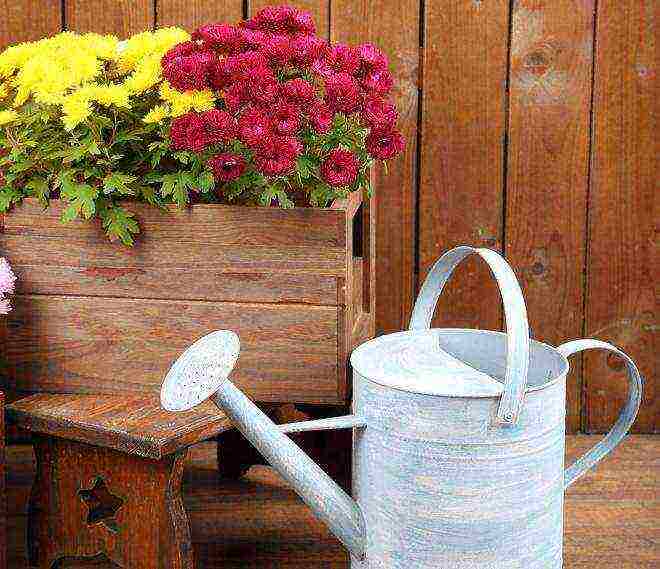 In the spring, before the flowering phase, they are irrigated very abundantly. The main thing is not to overmoisten the substrate. And when buds begin to form, watering is reduced. During the period of active flowering, it is gradually brought to a minimum. It is required to feed chrysanthemums regularly at intervals of once every two weeks. Mineral mixtures and organics are used. Once every few years, the bush is divided. For the winter, the culture should be covered, even if the variety belongs to the category of cold-resistant.
In the spring, before the flowering phase, they are irrigated very abundantly. The main thing is not to overmoisten the substrate. And when buds begin to form, watering is reduced. During the period of active flowering, it is gradually brought to a minimum. It is required to feed chrysanthemums regularly at intervals of once every two weeks. Mineral mixtures and organics are used. Once every few years, the bush is divided. For the winter, the culture should be covered, even if the variety belongs to the category of cold-resistant.
If the care is organized correctly, the chrysanthemum will be resistant to ailments and pests. But sometimes novice gardeners still make mistakes. Therefore, it is required to understand what diseases and parasites the chrysanthemum is prone to, how to deal with them.
Most often, the plant is attacked by aphids. These insects are capable of settling in a bush in whole colonies. The method of treatment depends on the degree of damage. For example, if several beetles are found, they can be collected by hand or the infected leaves can be cut off. But if the chrysanthemum is covered with aphids, special preparations are used. The most effective are Actellic, Calypso, Confidor and Aktara.
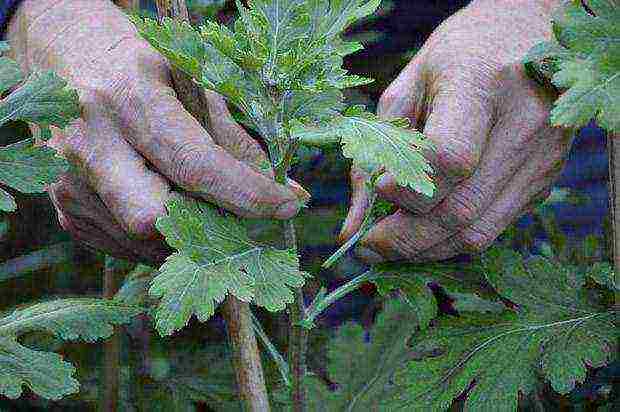 Often on the culture, you can see the activity of small roundworms - nematodes. They cause whitish spots on the leaves, lead to drying and curling of the leaf plate. The buds bloom, but they look very unsightly. To get rid of beetles, they are treated with a phosphamide solution.
Often on the culture, you can see the activity of small roundworms - nematodes. They cause whitish spots on the leaves, lead to drying and curling of the leaf plate. The buds bloom, but they look very unsightly. To get rid of beetles, they are treated with a phosphamide solution.
The most common diseases are gray rot, leaf rust and viruses. Rot is manifested by the formation of brown spots on the leaves. To fight, remove diseased leaves, spray the bush with Fundazol or Purest flowers. If there are small spots of a light yellow or pink hue on the leaves, rust is most likely. It is treated with fungicides, dressings. Viruses lead to yellowing, discoloration of foliage. Growth abnormalities are observed. There is only one way out in this case - to remove the chrysanthemum.
How to prolong the freshness of cut chrysanthemum flowers?
Chrysanthemum is a very beautiful flower. And it is often presented as a gift bouquet. This plant looks good in a vase. Chrysanthemums are cut at an acute angle. It is important to make an oblique cut. You always want the bouquet to last as long as possible.
There are some tricks, knowing about which, there is a chance to prolong the freshness of the flower.
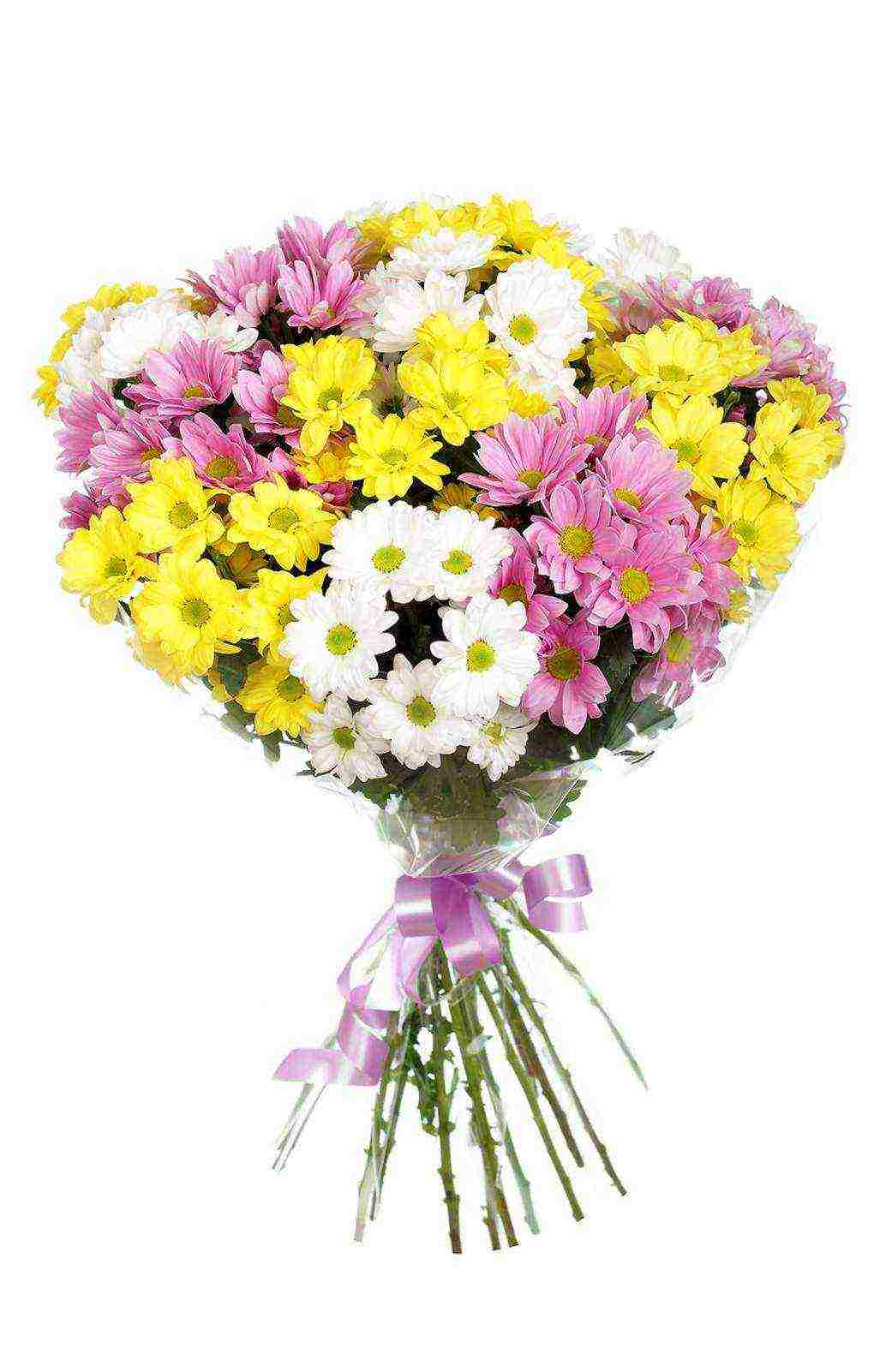 Options for how to preserve chrysanthemum are given below:
Options for how to preserve chrysanthemum are given below:
- When choosing a bouquet, you should give preference to fully blossomed specimens. It is advisable to cut the plant at the initial stage of flowering.
- Before placing a bouquet in a vase, you should carefully cut off each stem obliquely. To do this, use a well-sharpened knife.
- The foliage from the lower part of the stem is removed.
- It is better to use thawed or rain water. The plumbing must first be defended to get rid of chlorine.
- The liquid should be warm, room temperature.
- It is advisable to change the water daily or every other day.
- Trim the stems from time to time.
- Help prolong the freshness of the bouquet and occasional spraying with clean soft water.
- The vase should be placed away from heating appliances, protected from direct sunlight. Drafts, proximity to fruits and tobacco smoke also have a bad effect on the condition.
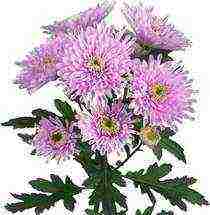 But all the same, after a certain time, the petals will begin to fall off. In this case, you need to know how to add freshness to the bouquet. Excellent helps to revive the culture of temperature shock. They spend it this way. First, place the chrysanthemums in cold water for a couple of minutes. And then they are kept in hot water for a short time. The part of the stem that has rotted is cut off. They put the bouquet in a vase of water, the temperature of which is at the level of + 19-23 degrees.
But all the same, after a certain time, the petals will begin to fall off. In this case, you need to know how to add freshness to the bouquet. Excellent helps to revive the culture of temperature shock. They spend it this way. First, place the chrysanthemums in cold water for a couple of minutes. And then they are kept in hot water for a short time. The part of the stem that has rotted is cut off. They put the bouquet in a vase of water, the temperature of which is at the level of + 19-23 degrees.
Shrub chrysanthemum grows in many garden areas. It is often grown on balconies, in pots. The cut culture looks good. There are different types and varieties of this flower. And each of them differs in the height of the stem, the size and color of the buds. In order for a chrysanthemum to flaunt on a personal plot, it must be properly planted and looked after in a special way. The plant usually does not cause any problems in keeping. We also advise you to look at the article: Jasmine shrub: characteristics, planting and care in the open field.
